- Fishing Kayaks
- Paddle Boards
- Life Jackets (PFDs)
- Boat Storage
- Paddling Clothing
- Paddling Accessories
- Cool New Gear
- Submit a Review
- Paddling Near Me
- Paddling Locations Map
- Download the Go Paddling app
- Paddling Trips
- Kayaking Trips
- Canoeing Trips
- Share Your Knowledge
- Add a Paddling Location
- Add Your Trip
- All Articles
- Getting Started
- Boats & Gear
- Techniques & Safety
- Camping & Survival
- Join Newsletter
- Create Account
- Message Boards
- Classifieds
- Photo of the Week
- Free Weekly Newsletter

How To Pack Your Kayak for a Camping Trip
So, you are finally out on the water and itching to spend more time outdoors – maybe go a bit further and explore, maybe spend a weekend at a spot that can only be reached by water, or maybe spend a week or more on an expedition. Whatever the plan, kayaks can help you pack and carry camping gear, and depending on the type of kayak you use, your carrying capacity may range from ultralight to super glamper. This article will hopefully have some tips and things to consider as you prepare to camp out with your kayak.
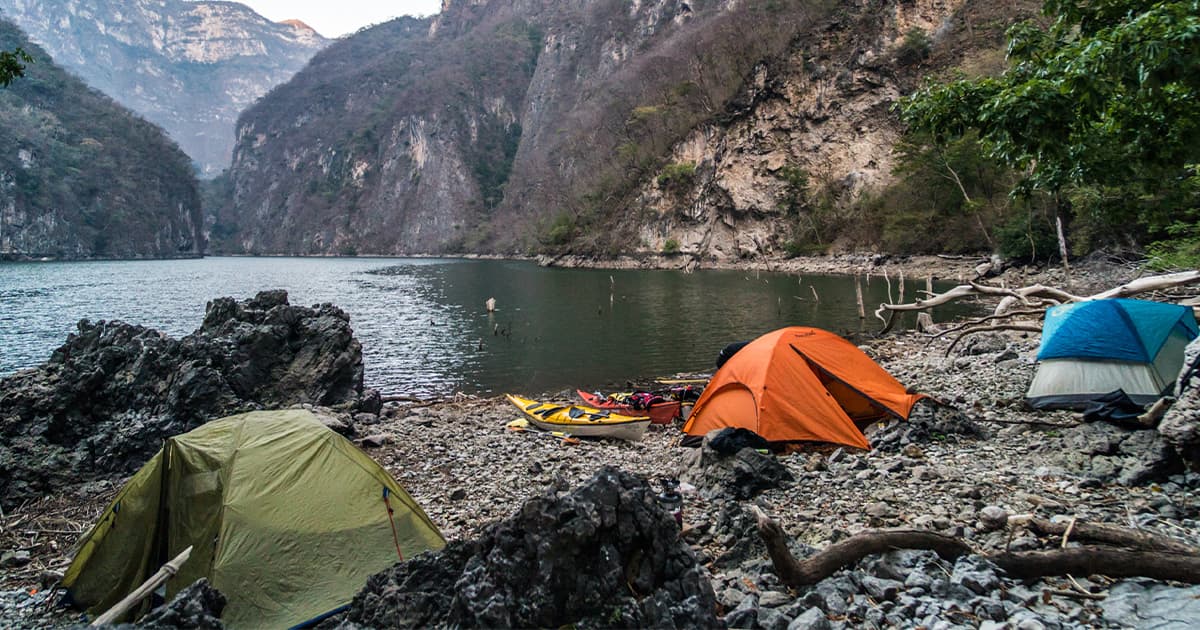
Different Types of Kayaks
First, let’s address different types of kayaks and what they may allow us to do. For a lot of carrying capacity, touring sea kayaks are fantastic. They will usually have 2-3 watertight hatches that can be filled with gear. For other styles of kayaks, such as surf skis, recreational, white water and sit on tops, you can now find lots of models and crossover models that have hatches and storage areas allowing paddlers to take more equipment than ever before. And while you can always stow a drybag on the deck of any kayak, being able to put gear away in hatches not only can help in keeping things dry but can help in keeping it away from the wind affecting your paddling.
Keeping Your Gear Packed and Dry
Are they always 100% watertight? The real-world answer is no. Don’t get me wrong, a new kayak with fantastic hatch covers will help keep water out. But it is possible that a hatch cover may not be closed all the way when getting out on the water, or a wave may pop a cover off, or many other possible scenarios having water getting in there somehow. So, when packing our gear, it’s a good idea to think of hatches as “mostly dry places” with the possibility of water getting in from time to time. That’s where drybags can help keep gear from getting wet while in hatches.
Are they always 100% watertight? The real-world answer is also no. And once again, don’t get me wrong, a new dry bag can be super watertight and may be for a long time. But there can be human error while closing them, as well as over time they might not be as dry as when they were new. So, keeping this in mind, you can use dry bags accordingly when packing camping gear. Use your best or newest ones on items you want to ensure stay driest, as well as potentially double bagging if needed. For me for example, most of my camping gear can handle getting a bit wet – but depending on conditions I might double bag my sleeping bag. After a hard day of paddling, I want to lay down and rest in a completely dry sleeping bag.
There’s different types, sizes, and materials for dry bags. Bigger ones make it easy to pack bulky items like sleeping bags, but many big dry bags can, in turn, prove hard to pack into kayak hatches. If possible, using medium and smaller ones in the mix can help in fitting within the different hatch shapes – much like playing a game of Tetris.
Our Top Picks for Dry Bags:
Baja Dry Bag by SealLine
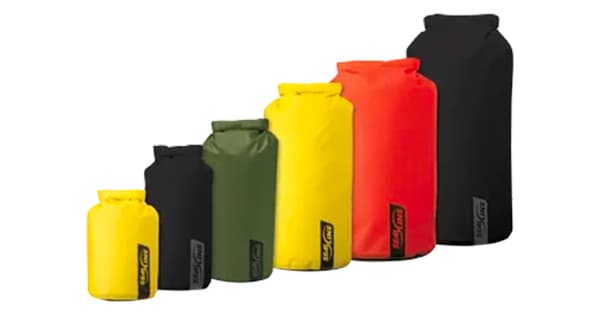
NRS High Roll Duffel Dry Bag
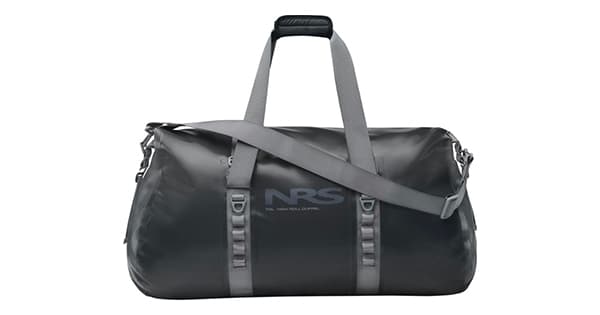
Best Dry Bags
There is nothing worse than wet gear, so check out these great dry bags ranging from 5L to 105L.
Deck bags are usually different types of drybags that are shaped to fit on a kayak’s deck and will often have straps to keep them attached and in place. They can be very helpful in keeping items easily within reach during a trip, like snacks, charts, or a camera. At the same time, you’ll have to consider how the wind will affect your handling when you add anything bulky to your deck.
Here’s an example of a deck bag:
Watershed Aleutian Deck Bag
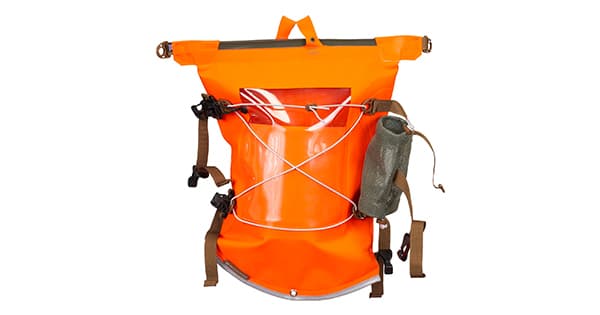
Watertight boxes
For must-stay-dry items such as electronics, sometimes a watertight box can be an option. Cases such as those made by Pelican and other brands have been around for a long time and are usually a go-to option for kayak campers. It might be worth testing how watertight it is indeed ahead of time depending on how valuable the item it will be protecting on your trip.
Here are some examples of watertight boxes:
Pelican 1060 Micro Case - for iPhone, GoPro, Camera, and More (Black/Clear)
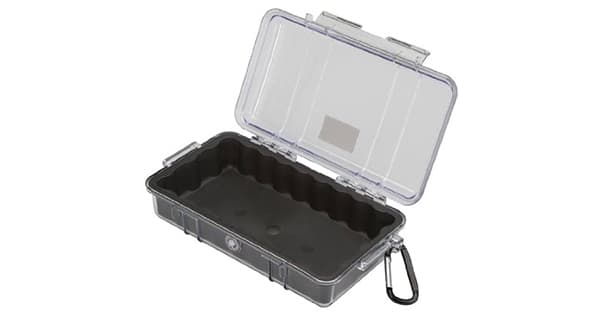
Pelican 1120 Case With Foam
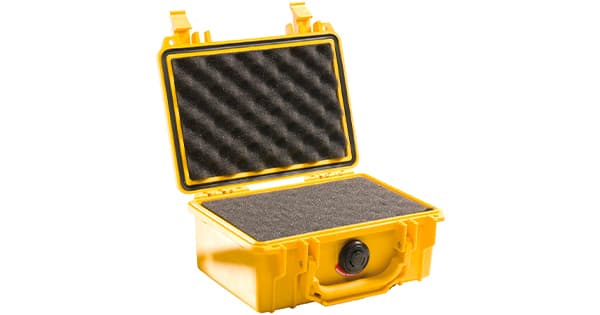
Gear Placement Within a Kayak
If you’ve never looked inside your hatches before, make sure to do so before your first trip. Different kayak hatches will have different shapes, and often their setup (skeg, rudder, etc.) will create interesting layouts and help you fit specific items. For example, my old skeg box allowed for items like tent poles, gas canisters, or beverage containers to be packed all the way to the end of the stern. Similarly, I’d usually separate my actual tent from the tent poles to take advantage of the skinny end of my bow.
TIP: When packing long sea kayaks, a good tip is to attach a bit of string or paracord to items in hard-to-reach places – that way you can pull on them to retrieve if they get wedged out of reach while paddling.
Distributing / centering weight front to back and side to side
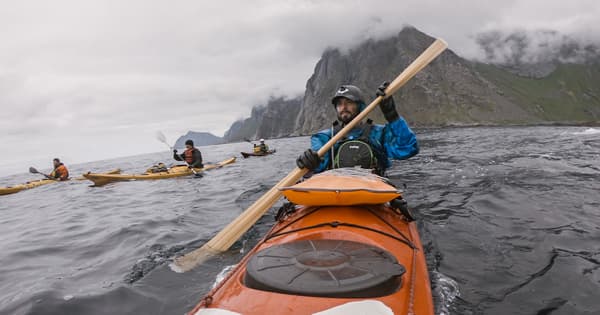
Just like when packing a car for a trip, you want to try to distribute the weight of your packed items in your kayak for the best possible handling. Try to keep heavy items as close to the bulkheads/middle as possible, as well as the centerline of the kayak. If possible, keep them on the bottom of the kayak as well (things like water bags, water bottles, etc.). The lower the placement of the weight, the better the handling. For example – something heavy at the bottom of the kayak hatch will help keep the kayak stable, while something heavy close to the deck or above the deck will make it more unstable. In the case of rolling, having heavy items at the bottom of the kayak will also help you as you try to get back upright. Also, use gear placement to your advantage to keep things from moving around. If things stay in place, it’ll make your handling more predictable vs. things moving around as you paddle.
TIP: If possible, try going for a test paddle with your kayak fully loaded to see what the handling will be like. That way you can be ready if you plan on tackling many miles at once, or a difficult location or crossing. Similarly, if it’s your first time packing your kayak, consider doing a packing trial before the trip to test where things will go. I’ve witnessed paddlers having to leave gear behind at the launch due to overestimating how much would fit in their kayak.
Packing gear in the cockpit
This is a tough area because not all kayak cockpits are the same. While many are roomy and might seem inviting for packing gear in, during a capsize the gear could shift around and potentially trap you in place depending on the shape of your cockpit. Personally, I try to fit everything I can in my hatches and keep my cockpit clear – also knowing that if I take a swim, the hatches will remain closed (and probably dry), vs. the cockpit filling up with water.
Also, keep in mind that if you carry loose items in your cockpit and take a swim, you’ll end up having a “yard sale” as you see your items (at least those that float) displayed for the group near you as you (and maybe your group) perform your rescue or recovery of choice.
Kayak camping is a wonderful combination of many different disciplines. Reaching and staying at hard-to-reach locations, venturing out on multi-day expeditions, a kayak can truly be a great camping adventure companion – allowing you to bring as little or as much equipment as needed (or that you can fit in it!).
Luke Rovner (Kayak Hipster) is a sea kayak instructor, photographer and filmmaker. Combining his experience as a photo and video professional with a love for kayaking, he started Kayak Hipster with the goal of capturing outdoor adventures and sharing kayaking tips.
Related Articles
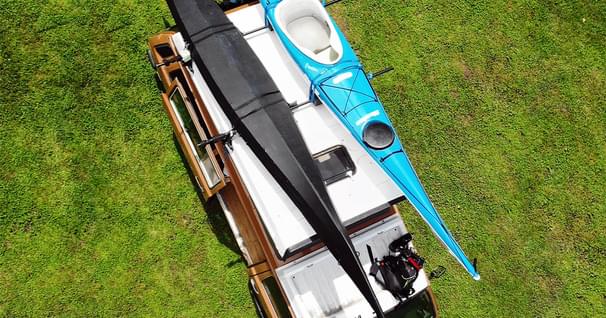
Kayak Transportation Tips and Tricks
After lots of research, maybe some classes, maybe some demo days, or maybe after finding the right sale…
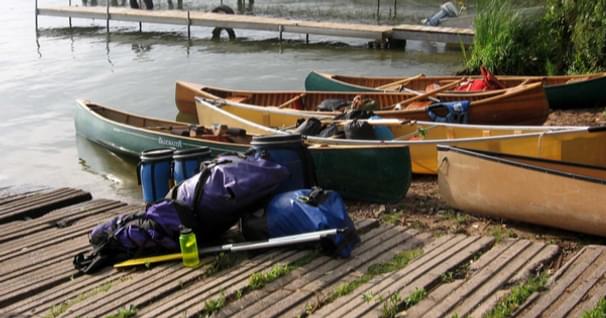
Plan for the Unplanned: Canoe Trip Essentials Beyond the Basics
You may recall Abraham Maslow ‘s hierarchy of needs from ninth grade social studies. Maslow says, you…
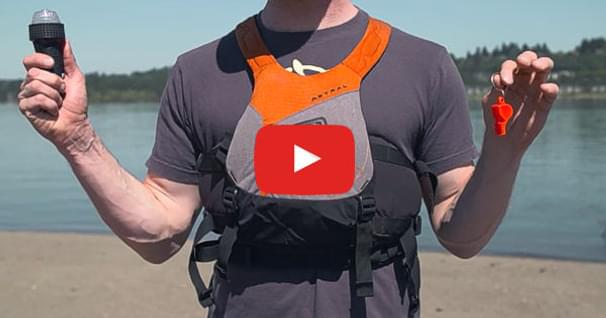
Essential Gear
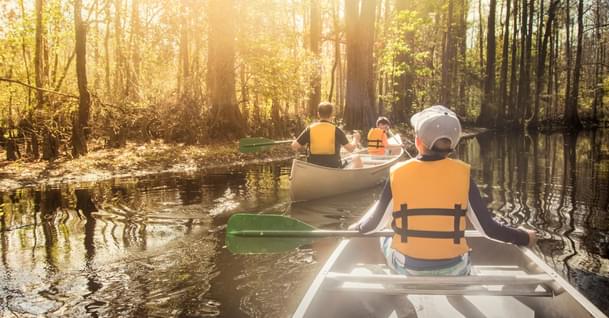
7 Tips for Successful Family Canoe Trips
Before I was domesticated, I spent more than a decade working paddling gigs between paddling trips.…
The Ultimate Kayak Camping Gear List
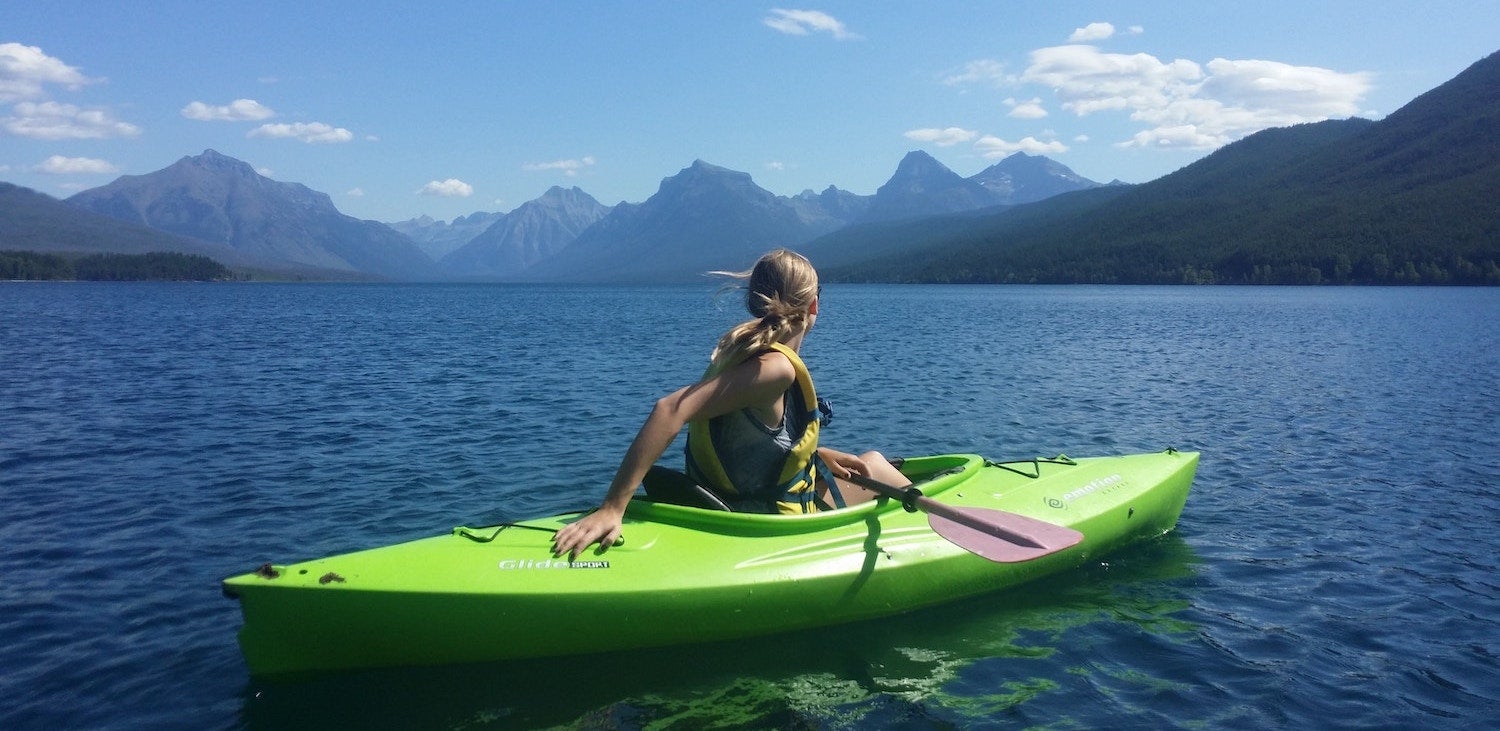
Rivers and lakes are features that we often seek out when camping. It is nice to have a place to cool off and spend the day. But what about using the water as your trail? Enter: kayak camping.
Kayak camping is similar to backpacking. You are camping and exploring long distance. The difference is, you don’t have to physically carry all of your weight on your back. Instead, you pack your kayak full of camping gear, and paddle away. You get the opportunity to enjoy the ebb and flow of the water, and explore places that might not be as easily accessible via a land route.
The Gear You Need for Your Next Kayak Camping Trip
There are still risks to using a waterway as your trail, but as long as you have the right gear, you can lower your risk, and increase your fun out on the water. With the help of my fellow Dyrt-bags, here’s a gear list to ensure that you have a great time on your kayak camping adventure.
For the Water
The kayak ($1,099).

You can’t kayak camp without a kayak. Though, full disclosure, and probably not much of a surprise, boats are not cheap. Kayaks built for touring or camping are no different. However, they are well-worth the investment if you plan to camp with your kayak often. Wilderness Systems’ Tsunami 125 is a kayak built for touring (long distance travel). This watercraft has two relatively large storage compartments, as well as bungies located on the top of the hull so you can tie extra cargo down. Whether you’re planning to embark on the open ocean, local stream, mountain lakes, or winding rivers, this kayak can handle it. If you’re just getting into kayak camping, and you aren’t ready to invest in your own kayak yet, try renting one from your local gear store first.
Prepare for your next adventure by downloading maps. The Dyrt PRO lets you download maps and campgrounds without cell service. “My alternative to using pro would be to drive back out to cell service”.
Kayak Paddle ($30)

No one wants to be up a creek, river, or lake without a paddle. This is why it’s important to purchase a floating paddle for your kayak camping trip. The SeaSense X-1 kayak paddle is buoyant and affordable. You won’t find a better paddle for this price. Regardless of how long your trip will be, don’t forget to pack a spare paddle ($36) as well, in the event you lose your primary one. We’re pretty sure that getting stuck in the middle of a lake isn’t on your camping itinerary.You can easily store a spare paddle by bunging it on the kayak’s deck.
Deck Compass ($55)
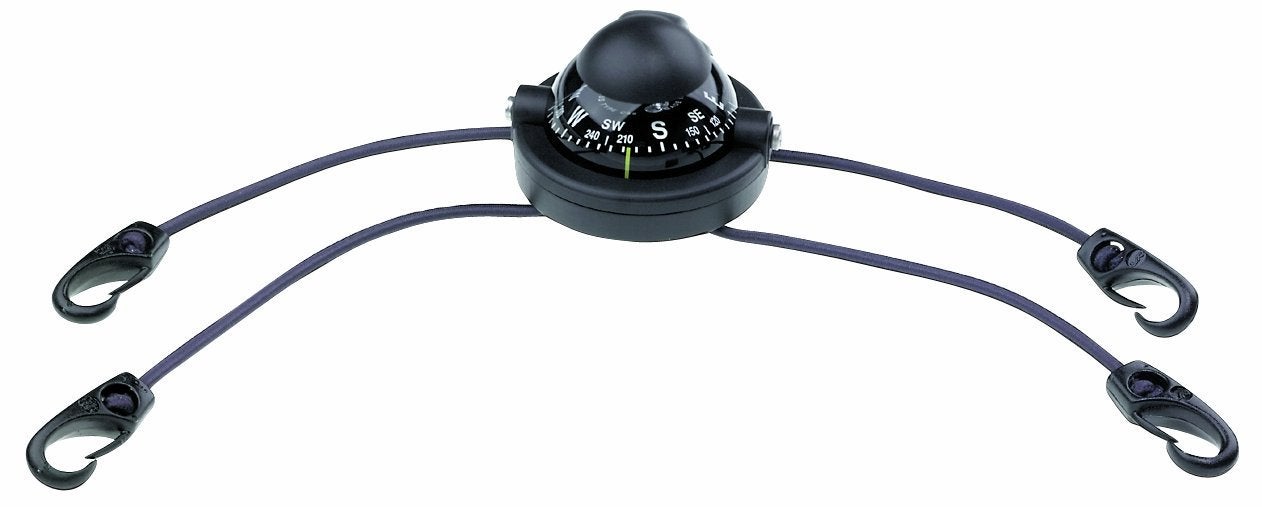
Whether you’re backpacking on dry land or kayak camping on waterways, you need to have a keen sense of direction, and a compass is often the key to that. Brunton’s kayak deck compass is waterproof and comes with straps so you can mount it on to your kayak deck. This is great to use on a foggy lake, a dim waterway, or if you’re ocean kayaking.
Dry Pack ($135)
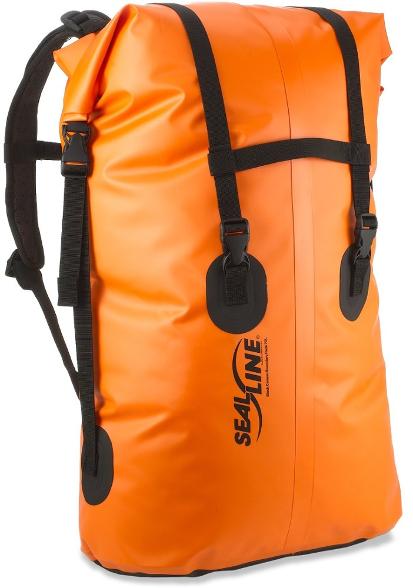
Dry clothing is a must on any camping trip. First, there’s the safety aspect — you need to be dry to stay warm. Second, wet clothing sticks to your skin like salt-soaked seaweed. It’s itchy, weighty, and most of all uncomfortable. A dry bag is an absolute must for kayak camping, and the SeaLine Black Canyon Boundary does not disappoint. Made with thermoplastic urethane encased nylon, this bag is perfect for long-distance paddling and camping. The straps also make it easy to transport when you’re on land.
Bilge Pump ($27)

In harrowing tales of boats taking on too much water, (and yes, we’re still sad about Rose and Jack in Titanic …) water in the hull is generally a bad thing. A swamped kayak can be uncomfortable, scary, and lead to a dangerous situation out on the water. Avoid that while kayak camping and get yourself a bilge pump. In kayaks and canoes, it can be quite common to get some water in the hull, given that the act of paddling can cause water to splash into the boat. This is why a bilge pump can be handy. Sea to Summit’s Solution Bilge Pump can extract almost half a liter from your kayak with its double action pump.
Kayak Repair Kit ($12)
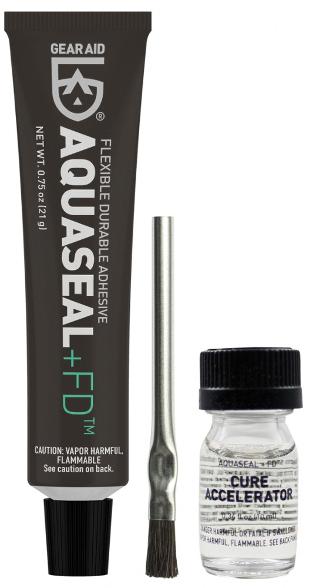
A bilge pump can help you bail out water, but it can’t repair a crack or hole from an unforeseen river rock. Good repair kits can help you get out of some rocky (pun intended) situations and get home safely. You can build your own repair kit using replacement rudder parts, bungie cords, static cord, bailing wire, a multi-use tool, sealant, and duct tape. Most of these kit items can be found easily at a local gear shop. As for a sealant, we recommend Gear Aid Aquaseal to keep repairs airtight.
For the Campsite
Waterproof headlamp $50.
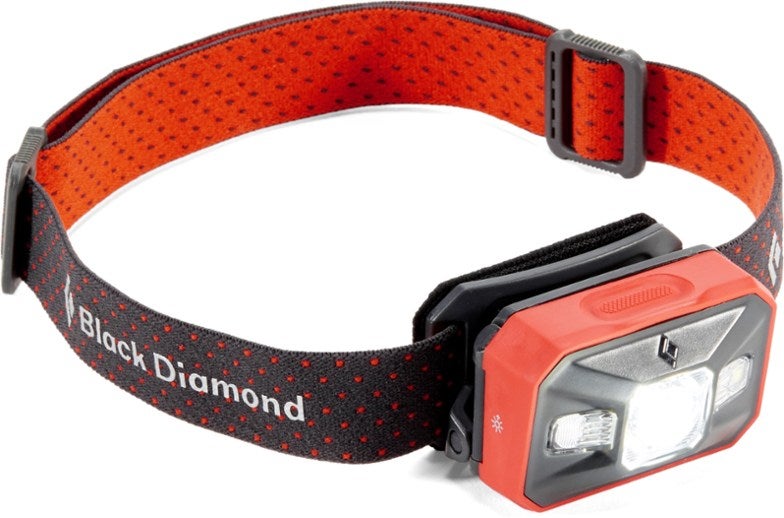
Most of the time, you kayak while the sun is out to play and head on land to set up your campsite before night rolls in. But just because the sun sets, doesn’t mean the fun have to stop. Black Diamond’s Storm Headlamp provides a bright beam to navigate the shoreline and the campsite. This headlamp is also waterproof, which is perfect for time spent paddling in the kayak.
Water Resistant Down Sleeping Bag ($299)
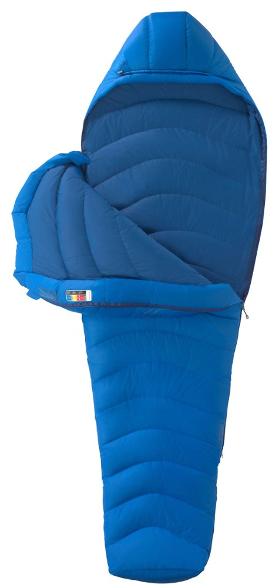
Wet sleeping bags are worse than wet blankets, that’s why the Marmot Helium Down Sleeping Bag is ideal for packing down in the kayak, and sleeping in at the campsite. The outer nylon has a water resistant finish, and the goose down has a Down Defender treatment so its more likely to resist water in wet conditions (like a boat). Plus, it maintains its warmth while still being lightweight. You’ll want to take this sleeping bag camping even if you’re not kayaking.
Lightweight Sleeping Pad ($130)

This sleeping pad is desirable for two reasons. First, it’s lightweight while still being comfortable. Second, it can be used as a lake floaty — we’re only half kidding. In all seriousness though, the Nemo Astro Lite Sleeping Pad comes with a built-in pillow, allowing you to pack one less thing. This sleeping pad also comes with a micro-adjust valve, which can help you reach your optimal inflation. With this pad, you’ll be dry, warm, comfortable all night long.
Multi-purpose Tent ($150)

A good tent can serve you anywhere–especially when you’re kayak camping. The Kelty Salida Tent is perfect for both the backcountry and for kayaking. It is easily packable, and so light you might forget about it altogether. This tent is ideal, whether you choose to kayak, backpack, or lay back and kick it at a campground.
Outdoor Water Filter ($40)
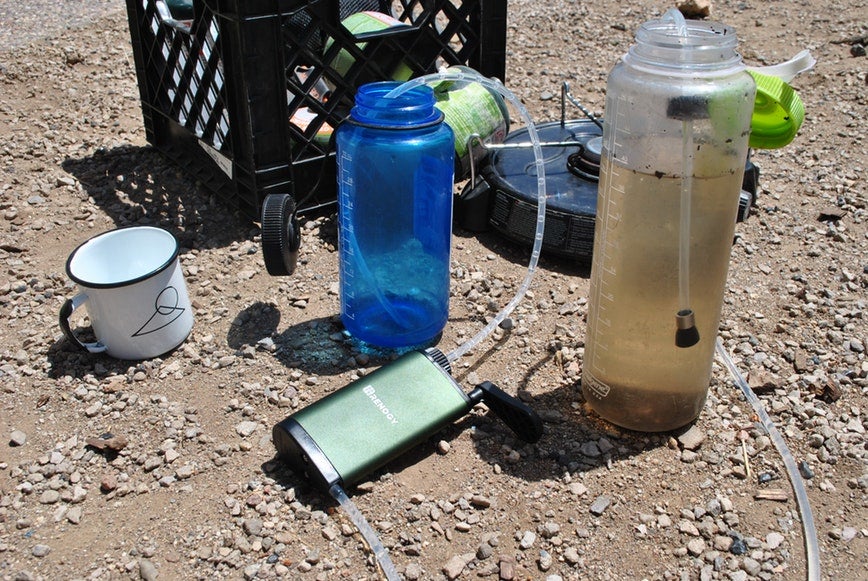
Photo courtesy of Dyrt Ranger Leah W.
When you’re on a kayak camping, you are surrounded by water. But it’s not a wise idea to drink straight from the source. This micro-water filter is packable, simple, and essential for any backpacking or kayak camping trip. Given some space restrictions in a kayak, it’s not always feasible to bring enough water for the trip. Renogy’s water filter ensures that you will be able to hydrate safely, so you won’t have to worry about giardia or cryptosporidium. This filter is designed for heavy use, so you can count on it lasting for plenty of kayaking, or backpacking trips, in the future.
Camping Stove ($115)
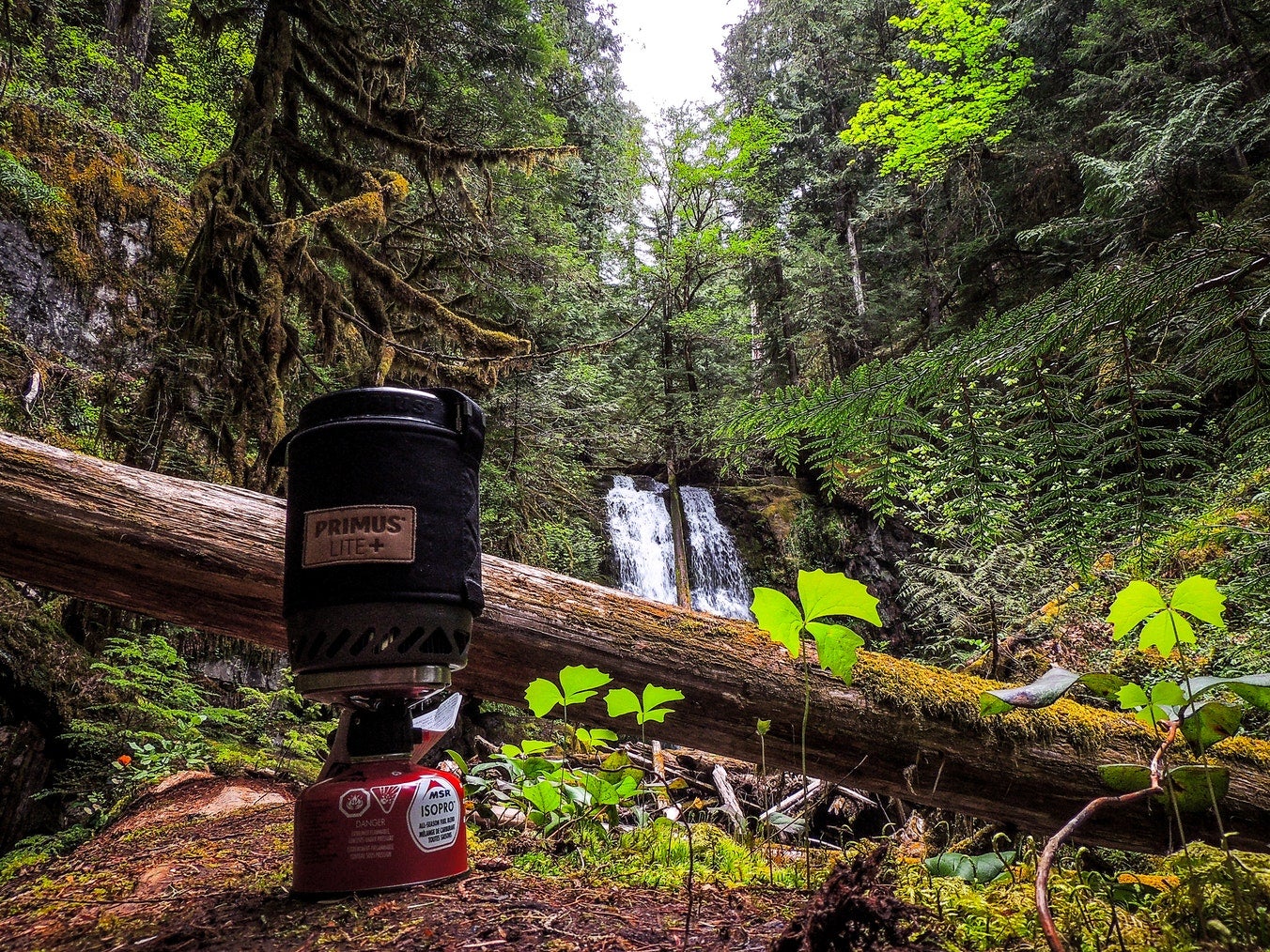
Photo courtesy of Dyrt Ranger Tj B.
A full two-burner camping stove can be a little much to bring for a kayak camping trip. The Primus Lite+ is a sturdy and compact, all-in-one camping stove that is easy to pack, and can whip up really quick dishes. This stove is built more for the solo backpacker or kayak camper, so if you want to share a stove, check out the Lite XL camping cookstove .
Food Utensils ($3)

Photo courtesy of Dyrt Ranger Chanel C.
Unless you plan to get your hands real dirty, you probably want to pack some utensils. That way, you can enjoy your camp cooking without the mess. GoBites can go from your home, into the backcountry, or to your kayak. They are versatile, BPA-free, and have a lifetime warranty. That means you can twirl endless amounts of spaghetti, right?
Soft-Sided Dry Bag Backpack Cooler ($100)
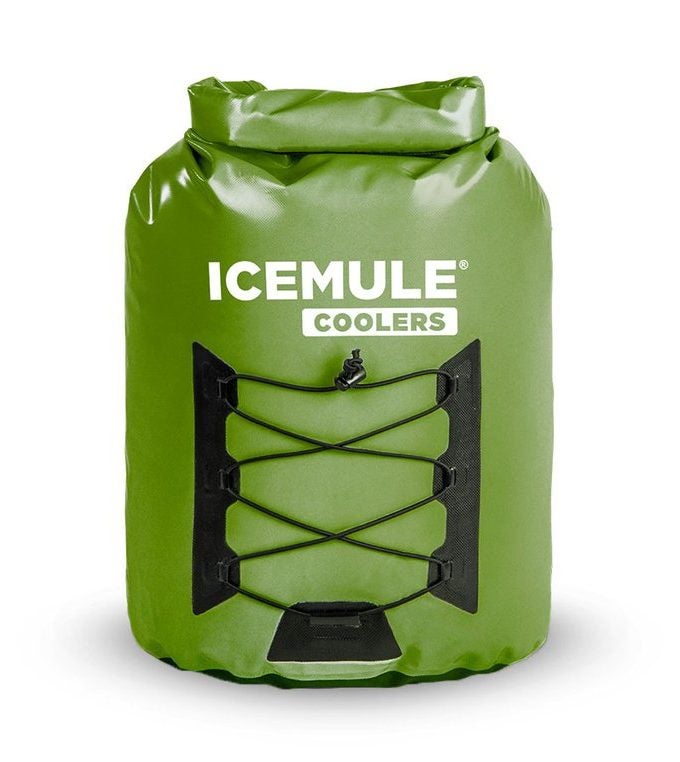
Coolers aren’t always the most mobile cargo, but it’s vital that you keep your perishables cold if you’re not opting for freeze-dried meals throughout your camping trip. The ICEMULE Pro backpack cooler is a handy backpack cooler that keeps your delicious food fresh, and you can just toss it on your back when you portage or hike to your campground. So, if you can manage the weight, don’t forget to pack the beers.
Water Resistant Duffel ($120)
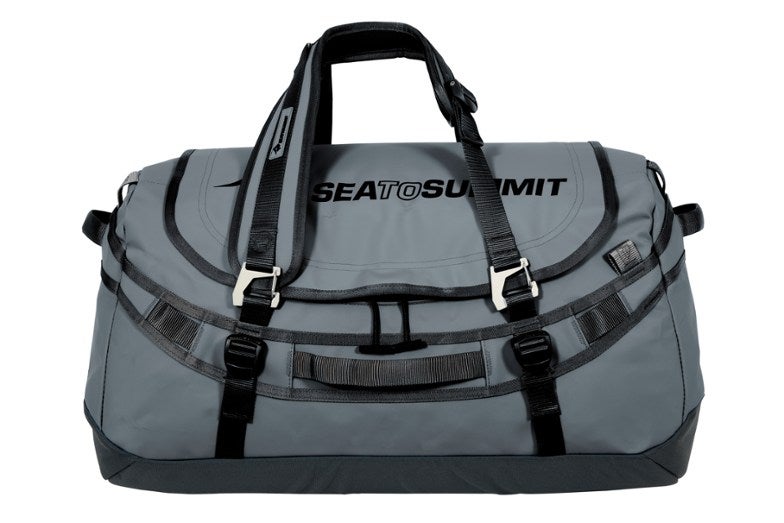
Whether backpacking or kayak camping, no one wants to get their clothes wet–though in kayaking, it’s a real cause for concern. This Sea to Summit duffel is perfect for kayak camping thanks to the waterproof material (though the zipper is not, so hopefully you and your cargo won’t be taking a swim). You can convert it into a backpack, too, which will make it easier to portage with your kayak and cargo. If you’re really getting after it on a river trip, and are concerned with water seepage, check out YETI’s Panga 75L Submersible Duffel , which is completely waterproof.
For Your Safety
Paddle-friendly pfd ($55).
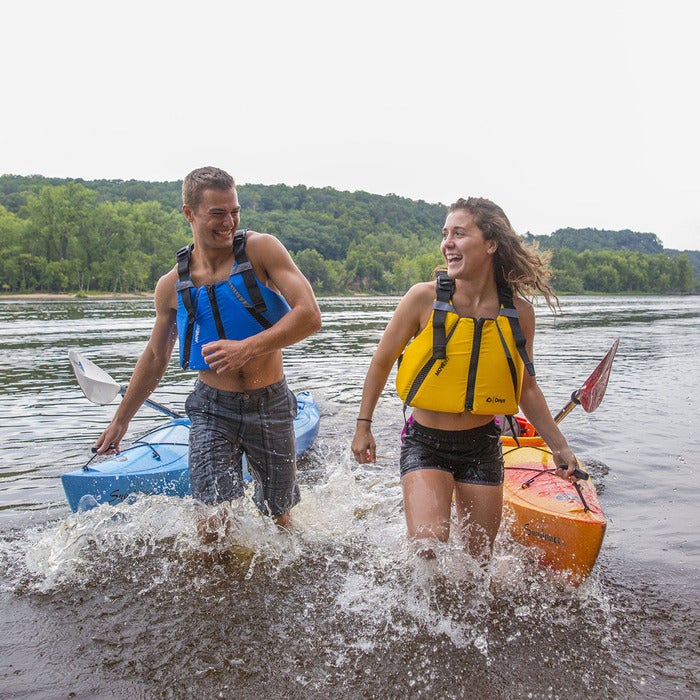
If you’re kayaking or canoeing on any type of water-way, you need a personal flotation device to ensure your safety. The Onyx MoveVent Curve Vest is made with the kayaker in mind, as it provides breathable mesh in the back so you don’t get too hot against the seat. It’s soft, lightweight, and flexible, which ensures that you’re comfortable, while staying safe– which is what really matters.
Waterproof First Aid Kit ($50)
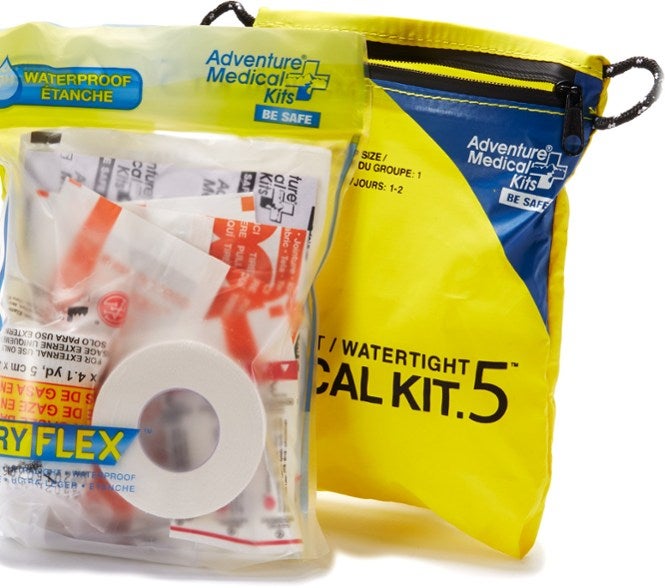
No matter what kind of hiking, camping, or backpacking you do, you should always carry a first aid kit. After all, you never know when something unexpected will happen. Most first aid kits should cover the basics: bandages, gauze, topical cream, and various medication. We recommend Adventure Medical Kits UltraLight / Watertight .5 First-Aid Kit . It comes with a waterproof case, which is perfect for days spent on the water.
Rescue Signal ($261)
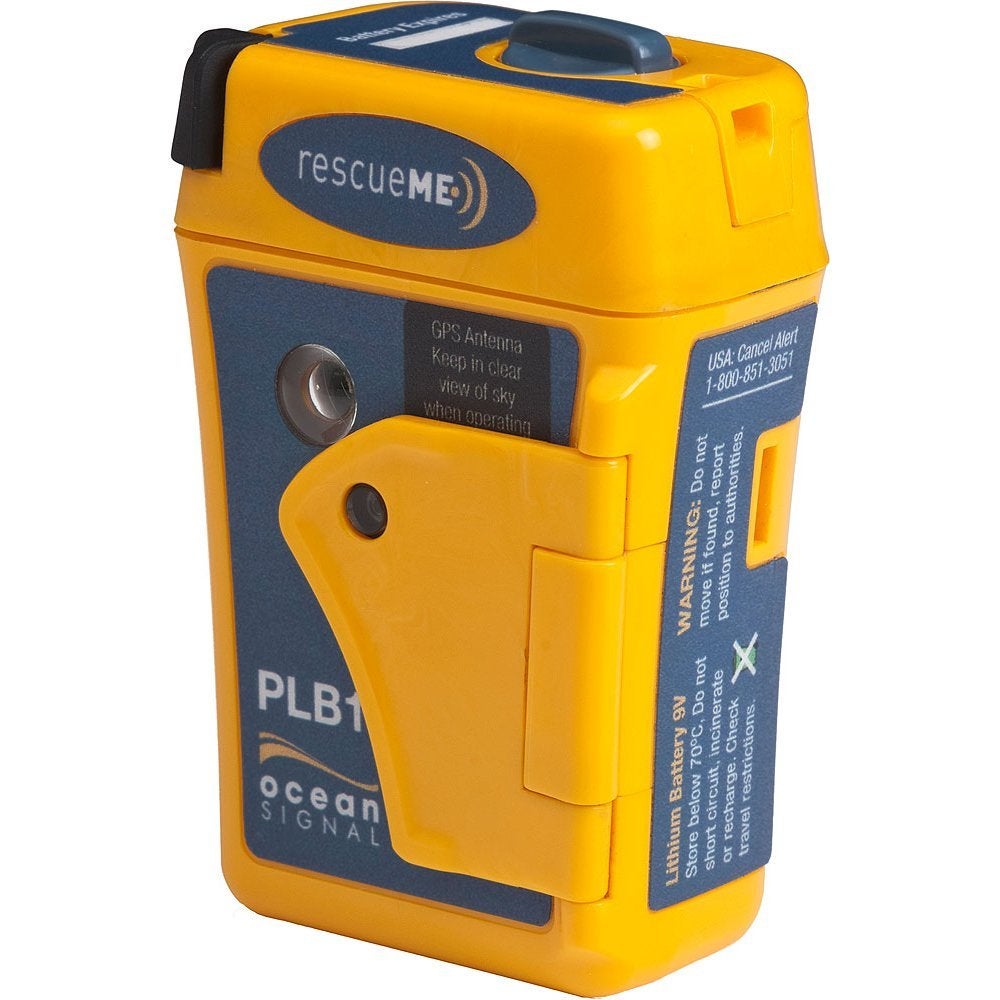
Situations sometimes come up when you need outside help, and you need it fast. A personal locator beacon can help you or a friend contact help even if cell service is not available. The Ocean Signal rescueME PLB1 has an emergency button that you can press if a situation is dire, and a signal will be sent via satellite to a rescue crew with your location. This PLB also floats–making it ideal for marine environments. The rescueME PLB1 is purely for SOS signals and does not enable two-way messaging. If you want the ability to message others, consider the Garmin Inreach Explorer+ at a much heftier price.
Knife ($45)
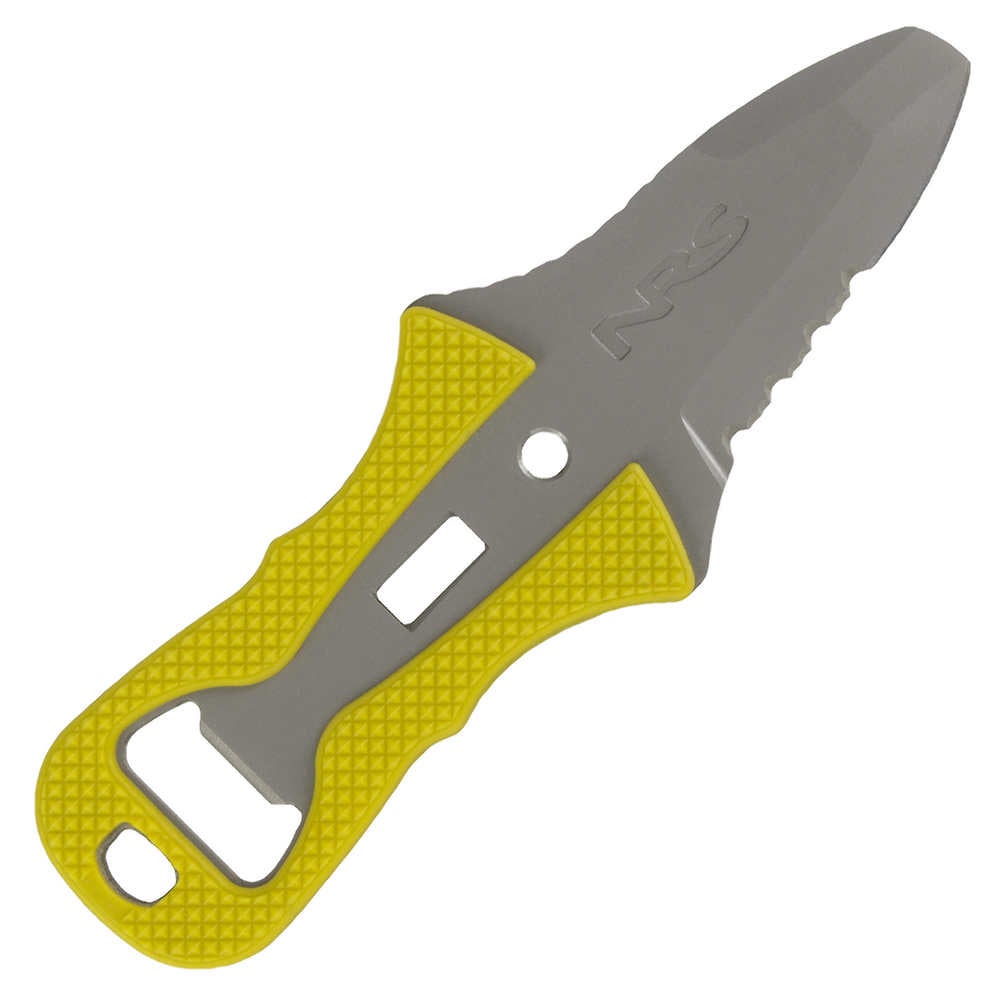
While a personal flotation device is a likely choice for safety, a paddling knife can easily go overlooked if you’re not a seasoned kayaker. Especially if you are participating in a river trip, a paddling knife is crucial. You never know if a situation might come up where you have to cut yourself away from your kayak. The NRS Co-Pilot Knife can clip onto your PFD with ease, and has two blunt sides, ensuring that you don’t get injured if you’re in a bind. The sharp side is serrated, so that you can cut through anything. If you plan to ocean kayak, be sure to get the titanium version so rust won’t be a problem.
Walkie Talkies ($70)
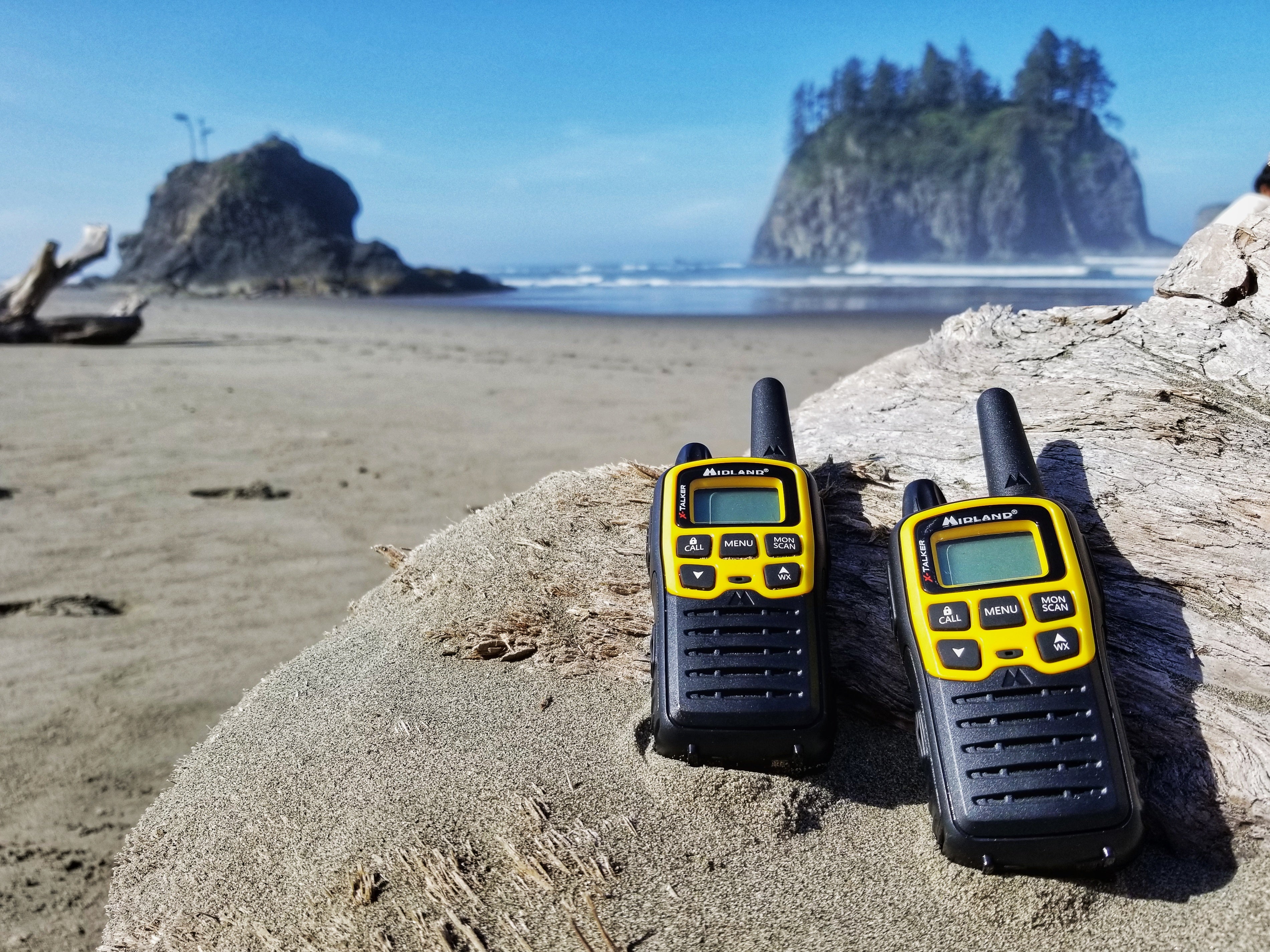
Photo courtesy of Kayla Haas .
If you’re kayak camping with friends in a remote area, there is a chance that you might get separated on or off the water. Midland’s X-TALKER T61VP3 walkie talkie can help you stay connected with your fellow kayak campers. These walkie talkies can also alert you and your party to what kind of weather might be rolling in.
Sunscreen ($36)
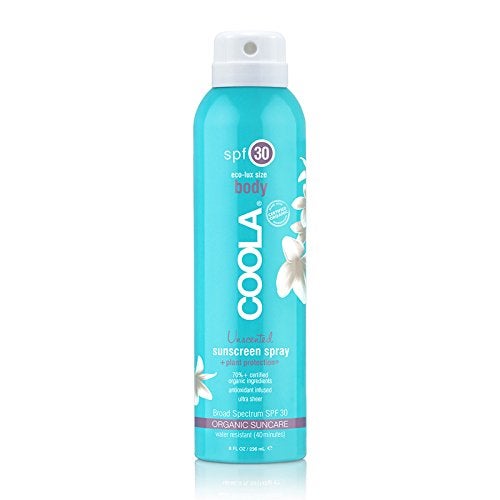
Plain and simple: UV rays are dangerous and being sunburned can ruin a camping trip. Lather up! COOLA Sport Continuous Spray keeps the grease off your hands, has a high SPF, and works while you sweat.
For Your Body
Rash guard ($78).
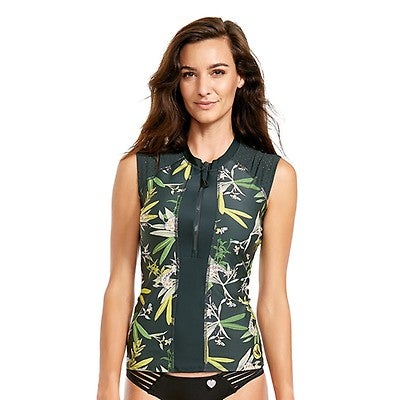
Though it might be the first thing that comes to mind, your bathing suit isn’t always the most practical item for a kayak camping trip. We definitely understand that you want to wear something that can easily get wet and dry off quickly. Body Glove’s Guava Exhale Rashguard is a great compromise–you can get wet, stay stylish, and be protected from the sun while you’re paddling. They offer a men’s version , too.
Rain Jacket ($189)
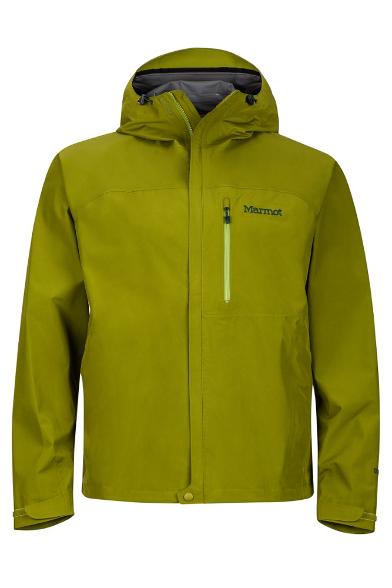
You should always prepare for a chance of rain in the forecast. Some places this might be less likely, like Death Valley , but you know what we mean. Being on or by the water means you can easily run into a rain storm that was not expected. The Marmot Minimalist Rain Jacket is great for staying active in the rain thanks to the waterproof, breathable shell. This rain shell is also perfect for backpacking given that it’s lightweight and tailored for movement. Don’t forget the Marmot Minimalist Pants for a full set.
Water Shoes ($80)

Hiking might be on your itinerary when you get to your campsite, but a lot of your time will be spent in your kayak or around the water. It’s important to have a comfortable, waterproof shoe that can transitions from land to sea. Vivobarefoot’s Ultra 3 Bloom is flexible and has great traction when they are wet or dry. These amphibious shoes are made using an algae, which also contributes to their sustainability, so you can feel good while wearing them.
Adventure Hat ($39)
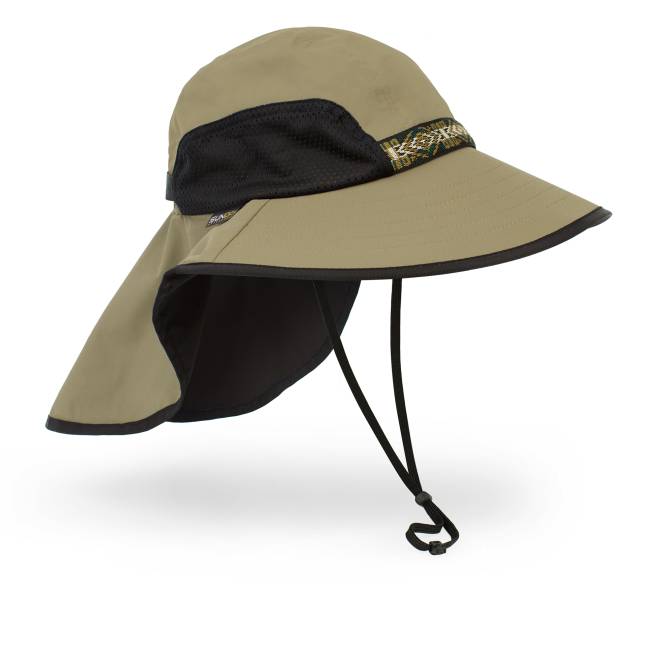
We’ve covered that sun protection is super important. A hat can also help protect you from strong UV rays. The Sunday Afternoons Adventure Hat has a four inch brim, and a flap back to keep you protected. It is also made out of lightweight material, so it is comfortable to wear. The best part of this hat for kayak camping? It floats. So if a gust of wind catches it, you won’t be in need of a replacement.
You can win free gear from Brunton and 19 other outdoor brands by reviewing campgrounds on The Dyrt. Share past camping experiences, photos, and videos to earn points towards monthly prizes in The 2018 Great Camping Giveaway !
Popular Articles:
- Get the Latest 2023 Camping Travel Trends
- How To Find Free Camping in National Forests
- The Checklist Every First Time RVer Needs
- Find Free Camping With The Dyrt Map Layers
- The Ulimate Boondocking Guide To Free Camping
- Everything You Need To Know About Wifi For Your RV
- 7 of The Best Overland Routes in North America
- 14 Wilderness Survival Tools You Should Have in The Backcountry
- Here's What To Add To Your Primitive Camping Checklist
Kristen Byrne
Kristen is a journalist turned digital account manager at The Dyrt. She has worked for various TV stations and newspapers, and now focuses on content creation for tech-loving outdoor enthusiasts. Chances are good she's outside, hiking, climbing, skiing, or exploring. Just know that you can count on her to bring canned wine to the campfire.
More Articles
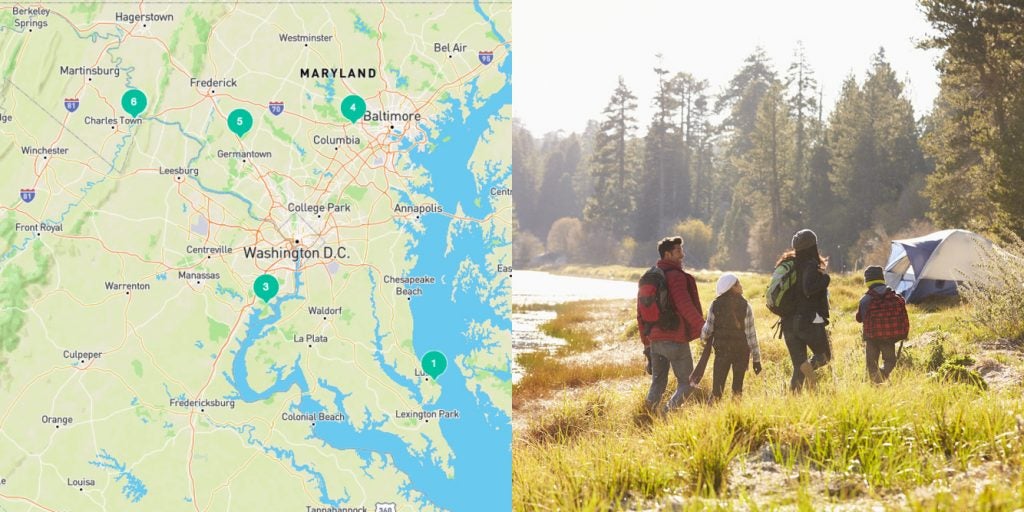
Choose Camping Near DC the Whole Family Will Enjoy
With each passing year, Washington DC continues to attract a record number of tourists, drawing 20.8 million visitors from within the United States alone in…

Ranger Camping Recipe: Quick and Easy Pad Thai (in a Dutch Oven!)
Oil leaking in your camp bin? Full ketchup bottle won’t fit in the cooler? Humangear has a solution: the GoToob+. Their new and improved silicone…
Just in time for Mother's Day, shop our 25 Best Mother's Day Gifts.
FIELD & STREAM+
- Join 1871 Club
How to Pack a Canoe or Kayak for a Camping Trip
Here's how to keep your gear organized (and dry) when you're paddling to your campsite
By T. Edward Nickens | Published Oct 26, 2022 12:00 PM EDT

We may earn revenue from the products available on this page and participate in affiliate programs. Learn more ›
Think of canoes and kayaks as giant, 16-foot-long duffel bags with few dividers, compartments, or pockets. Packing one for a camping trip can be a mess if you don’t have a plan, and a poorly packed canoe or kayak can be an unwieldy, dangerous craft. The right approach takes into account heavy gear, light stuff, gear you won’t need till darkness falls, and items you’ll want close at hand, such as a survival kit , map, compass, or bug dope. Whether you plan to paddle a canoe or a kayak, here’s the 4-1-1.
Arrange your gear in three piles. One is for stuff you won’t need until you’re making camp—tent, sleeping bag and pad, cooking gear, water, and most food. Another is for gear you might need while paddling, such as a fleece jacket or binoculars. The third pile is for gear you’ll want within easy reach: raincoat, sunscreen, camera, VHF radio, map, compass, safety gear, and light snacks. Pack gear in multiple dry bags so it will be easy to adjust, and keep the load centered side-to- side and low in the boat.
Canoe To-Do List
There are two schools of thought when it comes to loading a camping canoe:
- Pack everything in multiple smaller bags to make it easy to trim the boat for efficient traveling, or load up larger waterproof packs to make gear-schlepping easy. Unless you’re crossing big water and need maximum paddling efficiency, opt for the latter strategy.
- Divvy up the gear by function: All the food and cooking tools go into one pack. Another holds all the shelter items: tent , tarp, sleeping pads and bags, and the like. Add a personal gear bag for each paddler, and that makes for a load that can be moved around to keep the boat trim. Pack easy-to-reach items in a small bag that you tuck under or behind the seat. You’ll want those close at hand so you won’t have to tear the boat up looking for your lip balm.
Small coolers are handy on a canoe-camping trip. They can serve extra duty as cutting boards and camp chairs. Just be careful to either tie them tightly to a thwart or wedge them snugly in place with other gear bags. A heavy cooler that shifts around in a canoe can make the boat dangerously tippy.
‘Yak Attack
Pack gear in waterproof dry bags and think small; any bag with a diameter greater than a dinner plate likely won’t fit in kayak hatches. If you don’t have dry bags, pack in heavy-duty contractor bags and seal with zip ties.
Light items such as sleeping pads and bags go into the stem of the bow and stern. Heavy items such as water, food, and liquid stove fuel ride in the bottom of the boat and centered side-to-side. Moderately heavy gear—tents, cookware and stoves, and clothing—can go on top of the heavy items. Keep tent poles separate, and stuff them low in the boat between other gear bags. Large soda bottles are great for extra water. You can shove them into nooks and crannies where other gear won’t fit.
Space behind the seat is perfect for the small drybag of gear you’ll need on the water, plus a bilge pump and a few spare water bottles. Keep the deck free of bulky items that will throw off the boat’s balance or catch the wind. Stow a spare paddle and waterproof map case under the deck bungees, but that’s it.
This article was adapted from Field & Stream’s Total Camping Manual .

T. Edward Nickens has covered sporting, conservation, and outdoors culture topics for more than 35 years. His work has appeared in Field & Stream for more than two decades, and includes features, his regular column, “The Total Outdoorsman,” five Field & Stream books, and the anthology The Last Wild Road.
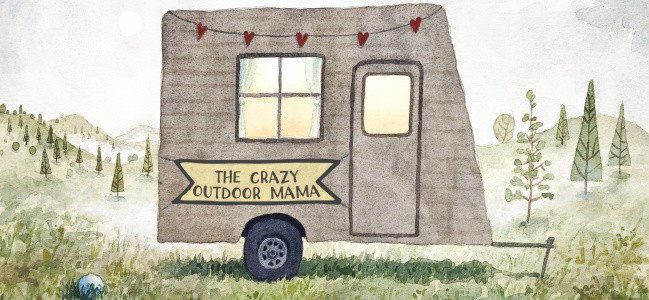
Packing a Kayak For Camping | Complete Guide + BONUS Packing List
Updated January, 2022
You’ve got your boat and a location scouted for your camping trip, and now it’s time to start packing your kayak for camping. Is it time to start strapping stuff to your kayak, cramming food in the hatches, and whatever doesn’t fit, just add it to the ginormous backpack you’ll be carrying.
Whoa… slow your roll.
That’s a good way to end up with a top-heavy, out of trim kayak that’s impossible to control. Packing a kayak for camping takes time and practice – especially if it’s your first kayak camping trip.
So hunker down for the next 5-10 minutes and give this article a careful read. I’m going to talk about how to pack a kayak for camping so it’ll be…
Plus, you’ll get a few extra tips and a packing list that’ll make your life waaaay easier and save you some major frustration when packing for your kayak camping trip.
*Psst…just in case you haven’t seen it, don’t miss my Ultimate Guide to Planning Your First Kayak Camping Trip .
Ok, now we’re ready to start packing!
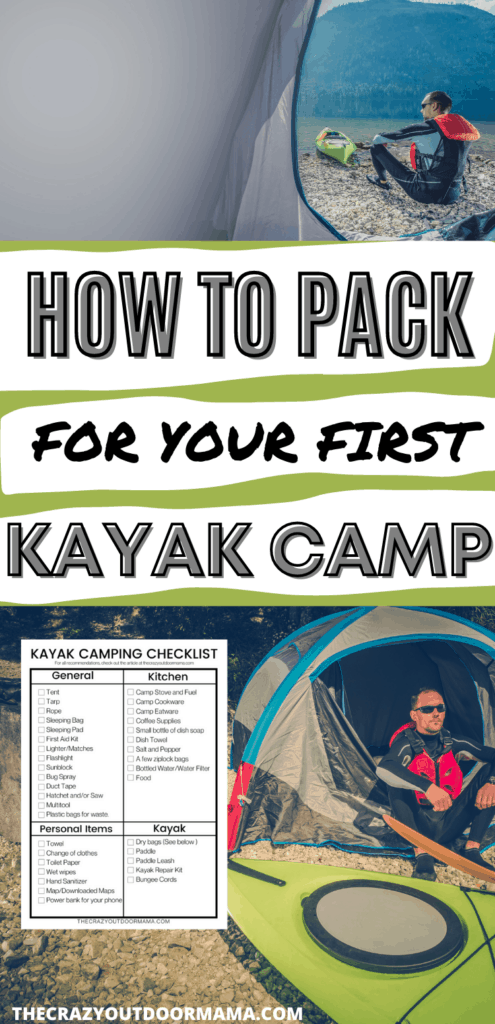
Keep Your Kayak Light
Usually, the heavier something is, the harder it is to handle. We’ve all proven that’s true when trying to get out of a recliner after stuffing ourselves at a family dinner. 🤣
The same is true with your kayak. Pack it with too much heavy camping gear and it’ll sit lower in the water, be harder to paddle, and harder to turn. You might not notice it in the first few minutes of paddling, but after a few hours, you’ll be wishing you hadn’t brought your cast iron frying fan.
So what can you do to keep it light?
Plan Well: Use my downloadable packing list as a guide. Pack your kayak as if you’re going on a backpacking trip. Sure, you can pack a little more since you won’t actually be carrying gear on your back, but you’ll still be moving everything you bring with your own power.
So choose wisely and pack lightweight items.
- Bring a backpacking tent and not your normal family camping tent.
- Pack a lightweight sleeping pad instead of an air mattress.
- Bring a compact camp kitchen set .
- Pack boxed or canned wine instead of a heavy glass bottle.
Pack As a Group: If you’re going with friends or family, plan what you pack as a group so you don’t bring unnecessary stuff. Plan on sharing a cook set, a tent, or other camping gear so you don’t end up packing doubles.
Don’t show up to your campsite with 3 friends realizing you each just paddled 5 miles upriver with extra weight since you all packed 4-man tents.
Ok, so you’ve figured out what you’re going to pack. Now let’s move on to where you should pack things in your kayak.
Pack Your Kayak So It’s Balanced
Proper weight distribution throughout your kayak will make it a lot easier to handle. Here are a few things to keep in mind.
Keep Your Kayak Stable: To do this, pack your kayak so it’ll have a low center of gravity. Pack the heaviest items low in the boat, towards the center, and evenly from side to side.
Keep Your Kayak in Trim: This refers to your kayak’s tilt front-to-back. A poorly trimmed kayak can be hard to handle, especially in strong currents or wind.
So try to distribute the weight evenly between the bow and stern. This may take some trial and error. Once you’re at the water’s edge and have everything packed, take a seat in your kayak as if you were paddling and check out its trim. Then you can repack things as needed before heading out on the open water.
Here’s a simple diagram that can serve as a reminder of where to pack items of different weights in your kayak.
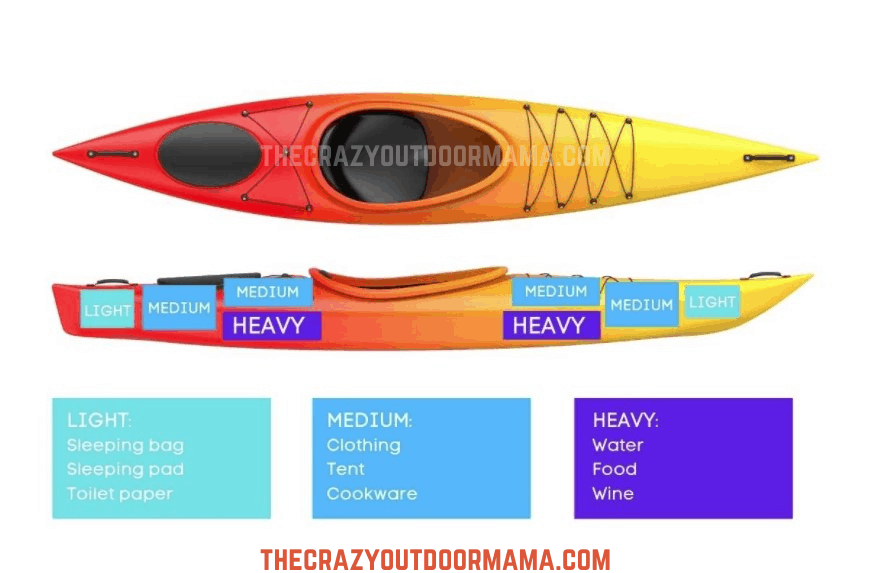
Keep Things Dry
Dealing with water is one of the main things that sets kayak camping apart from regular backpacking trips.
So what’ll happen if your kayak overturns and your stuff ends up in the river? How can you prevent everything from getting soaked?
Two things – Hatches and Dry Bags
Most kayaks for camping have waterproof hatches where you can safely store your gear. Just load up the compartment and then seal the hatch lid.
*If you’re looking for a kayak for camping, don’t forget to check out my article on how to choose a kayak for kayak camping .
If you don’t have enough hatch space and need to pack kayaking gear on the outside of your kayak, then dry bags will be your best friend. They’re made from durable, waterproof materials with special closures to keep water out.
Here are some good choices for dry bags you can use when packing your kayak for camping. And for more info check out my article on how to choose the right dry bags for kayak camping .
Earth Pak Waterproof Dry Bag
Eark Pak Waterproof Duffel Bag
Yeti Waterproof and Submersible Bags
A quality waterproof phone pouch like this one can be a real lifesaver as well and can even double as a pouch to carry important papers or your ID.
Depending on how much you trust your kayak’s hatches, you might still want to pack some essential items like matches, sleeping bags, a first aid kit, or food in plastic bags as an extra layer of protection. This could mean just putting it in a durable ziploc bag or in a small dry bag.
There’s nothing more discouraging than arriving at your campsite only to realize your hatch cover popped loose, some water got in and now your sleeping bag is completely soaked.
When it comes to keeping things dry, it’s better to be safe than sorry and add an extra layer of protection where possible.
So you’ve figured out what you’re going to pack and how you’ll keep it dry. Now let’s look at how to stay organized.
Pack Your Kayak So It’s Organized
Have you ever been hiking and just couldn’t seem to find something in your backpack even though you were sure you brought it? While kayak camping, you’re packing more gear that’s spread across a variety of bags and hatches. That means it’s even easier for that to happen with the gear you’ve packed for kayak camping.
So how can you pack your kayak for camping so you can find everything easily? It boils down to thinking about what you need and when you need it .
For example…
When will you need your sleeping bag? In the evening once you’ve got camp set up. Since that’s one of the last things you’ll need, you can pack it deep in the bow or stern of your boat.
When will you need snacks and water? While you’re out on the water paddling. So make sure you can easily access them without having to get out of your kayak. The last thing you need is to tip your boat in the middle of a lake because you were rummaging around trying to find your cookies. (It can happen easier than you might think.🤪)
So as you pack each item it’s good to stop and think… When will I need this and how will I get to it when I need it?
Keep emergency items close at hand. Your waterproof first aid kit shouldn’t be buried deep in a hatch next to your sleeping bag. Make sure it’s easily accessible.

The same is true for other essential safety items like emergency paddles , safety rope , and navigation gear.
What to Pack
Want a complete list of what to pack for your overnight kayak camping adventures? Go to…
Ultimate Kayak Camping Checklist + FREE Downloadable Gear Lists
Here’s a basic idea of what to pack in addition to your normal camping gear (lightweight tent, sleeping bag, stove, cookset, etc.)
- Kayak repair kit
- Marine first aid kit
- PFD (Personal flotation device)
- Spare Mini Paddle
- Spray skirt
- Cockpit cover
- Check out the article I linked to above for more specifics.
Now you should have a better idea of what you’ll pack and where. Does that mean you’re ready to head out on the water?
There’s one more thing you should do, especially if this is your first time camping with kayaks.
Practice Packing Your Kayak for Camping
Now it’s time to head out to the backyard and practice packing your kayak for camping while you’re still on dry land. Sure, it’s an extra step, but it’ll save you big headaches in the long run.
Many first-time kayak campers have started packing their kayaks for the first time at the water’s edge only to realize they could fit everything they planned to pack. Or they realize their kayaking gear doesn’t fit through the hatch openings. Oh noooo!
If you do a practice packing run, you may also find that you have more space than you realized (and can pack an extra can or two of spam!) YES!
Bonus Tips for Packing Your Kayak
- Divide some essential items up into different bags. For example, if you’re packing two changes of clothes, don’t pack them both in the same dry bag. If something happens and water does get into that bag, ALL your clothes will be wet. But it’s very unlikely that two dry bags will fail, so you’re more likely to always have a set of dry clothes no matter what.
- As you plan how to pack your kayak, first, get to know your kayak . Some kayaks have hatches with surprisingly small openings. Double check to make sure your camp cook set or tent will actually fit through the hatch opening. Double-check that your kayak’s hatches are actually waterproof so you’ll know how many dry bags you’ll need to buy.
- Pack different items in different colored dry bags so it’s easier to remember which is in each without having to open them. Red = Emergency, Blue = Clothes, Brown = Toiletries
- Download my free CHECKLIST below with all the kayak camping essentials you’ll need to pack and use it to help you plan.
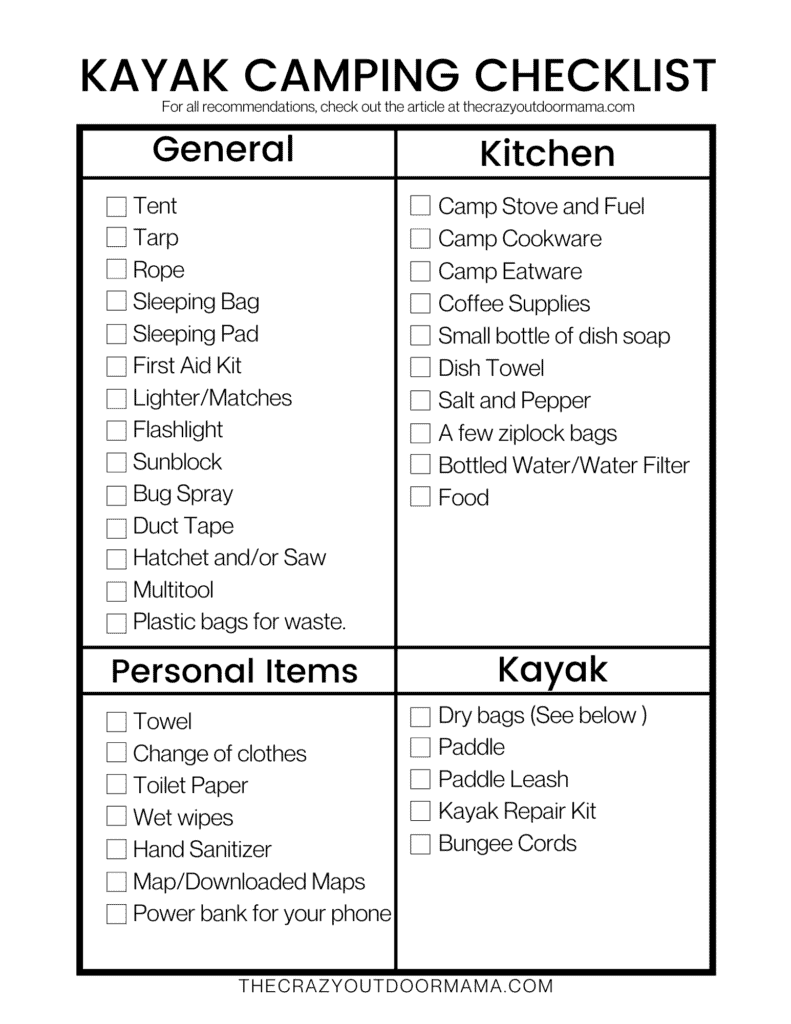
Ready to Start Packing Your Kayak For Camping?
Properly packing your kayak for camping is one of the most important steps to make sure you enjoy your kayaking trip. So follow the tips in this article and get ready for an awesome new kayak camping adventure!
I’d love to hear how your first kayak camping trip went and swap some funny camping stories, so don’t forget to follow and say hi on the socials.
And of course, for more help planning your next kayak camping trip don’t forget to check out these posts…
- THE ULTIMATE GUIDE TO YOUR FIRST KAYAK CAMPING TRIP (+PACKING LIST)
- 12 Best Kayak Trailers for Easy Kayak Transportation
- 8 BEST KAYAKS FOR YOUR FIRST KAYAK CAMPING TRIP – COMPLETE GUIDE `
- Sit on Top Kayak Camping 101 | Packing Your Sit On T op
- KAYAK CAMPING DESTINATIONS – 5 OF THE BEST PLACES FOR YOUR FIRST OVERNIGHT KAYAK TRIP
- Best Kayak Camping Gear | 19 Items You Can’t Go Kayaking Without
- CAMP COOKING FOR KAYAKERS | YOUR KAYAK CAMPING KITCHEN GUIDE
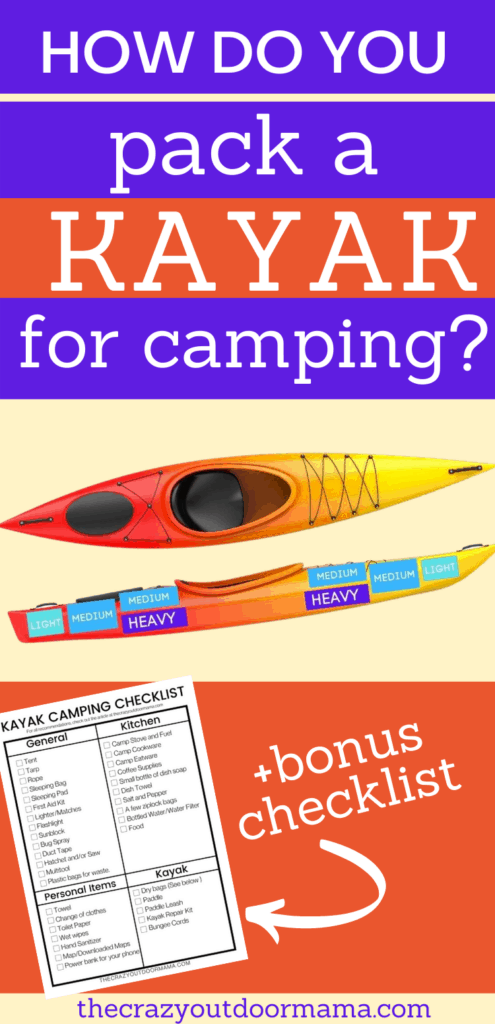
- Latest Posts
- Which Iconic RV Character Are You? Take the Quiz! - May 2, 2024
- Are You an RV MASTER? Take the Quiz and Find Out! - May 2, 2024
- Find Your Camping Spirit Animal With This Fun Quiz! - April 29, 2024
1 thought on “Packing a Kayak For Camping | Complete Guide + BONUS Packing List”
This is great! We started canoe camping a number of years ago on Texas rivers. Here is how I pack for a multi-day trip. The kids & I had funning putting this together. Enjoy! https://youtu.be/p3z4yTxzeEc
Leave a Comment Cancel reply
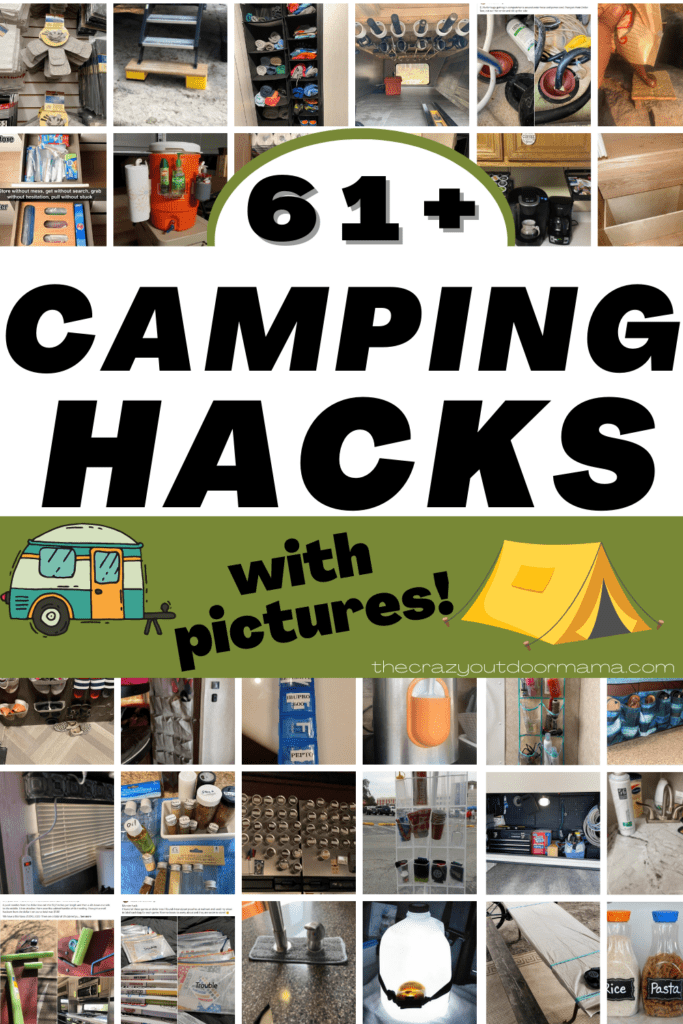
HI! I'm Stacy, AKA “The Crazy Outdoor Mama”
I'm the voice behind the website, and I hope you've found what you needed! I'm an outdoorsy married mother of three from Wyoming, and I LOVE creating resources that make camping and other outdoor activities easier!
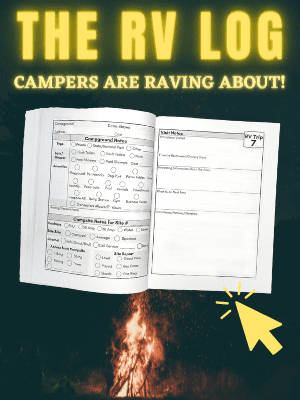

Ultimate Guide To Kayak Camping: Planning, Packing, & Gear
As the saying goes, “Adventure is the spice of life,” and kayak camping takes the cake when adding that extra dash of excitement. We’ve traversed countless waterways, witnessed breathtaking starlit nights, and now, we’re thrilled to pass on our wisdom to you. This comprehensive guide is your ticket to a seamless kayak camping experience, covering everything from meticulous planning and savvy packing to selecting the ideal gear for your expedition. We’ve explored tranquil waters and scouted the finest campsites, ensuring you have all the information you need to embark on your own unforgettable kayak camping adventure . We’re here to assist you in every step of the way as you prepare for the Ultimate Guide To Kayak Camping, starting with choosing the perfect kayak that offers both comfort and ample storage for your gear. And speaking of gear, we’ve got you covered with our top-notch packing tips to keep your belongings dry, secure, and easily accessible throughout your journey. Safety is paramount, and we’ll provide you with a comprehensive list of essential equipment to ensure a secure and enjoyable trip. As members of this vibrant outdoor community, we embrace the ethos of leaving no trace and enjoying nature responsibly. We’ll share valuable insights on minimizing your environmental impact, preserving the pristine beauty of the wilderness, and fostering a deep connection with the natural world. So, grab your paddle, gather your camping essentials, and get ready to embark on an unforgettable odyssey into the heart of the great outdoors with kayak camping. Let’s forge memories that will last a lifetime as we embrace the serenity of nature and savor the thrill of adventure . The wonders of kayak camping await!
Key Takeaways for the Ultimate Guide To Kayak Camping
- Kayak camping offers the adventure of kayaking and the serenity of being on the water, without the heavy load on your back.
- When choosing a location for kayak camping, start with a calm water destination such as a lake or river, and consider staying at established campsites.
- Essential gear for kayak camping includes dry bags for packing and keeping gear dry, a personal flotation device (PFD), and a lightweight backpacking tent or hammock for sleeping.
- When packing a kayak, use strategic packing techniques such as using dry bags to keep things organized, distributing weight evenly, and keeping essentials easily accessible in a waterproof fanny pack or sealed compartment.
Choosing the Right Location
When it comes to selecting the ideal destination for our kayak camping excursions, we seek a harmonious blend of tranquility and adventure. Choosing a serene waterbody, such as a picturesque lake or meandering river, sets the stage for an extraordinary journey. As we immerse ourselves in kayak camping, it is highly advisable to opt for established campsites, particularly for those new to this exhilarating experience. These designated areas provide a comforting sense of security and convenience, allowing us to fully embrace the joys of kayak camping without the weighty burden of a cumbersome backpack. It is a refreshing and innovative way to embrace the great outdoors, offering us a unique perspective and a profound reconnection with the boundless wonders of nature. As we navigate uncharted waters, honing our navigation and location-tracking skills becomes paramount. Equipping ourselves with reliable tools such as maps and compasses is our unwavering guide, ensuring that we remain on the right course throughout our journey. In addition to traditional tools, we can leverage the technological advancements at our fingertips by downloading essential information onto our smartphones, enhancing our ability to navigate with unwavering confidence. Let us always remember that kayak camping is a shared adventure, and each voice contributes to the tapestry of memories we weave together. This is the essence and beauty of kayak camping—it fosters a profound sense of belonging, encourages exploration, and forges unbreakable bonds amidst the natural tapestry that surrounds us. So, let us embark on this extraordinary odyssey, where the gentle ripples of the water serenade us into tranquility, and the stars above illuminate our path. Together, we shall craft indelible memories, embrace the spirit of camaraderie, and unveil the wonders that await us in the enchanting realm of kayak camping . With hearts filled with anticipation, let the grand adventure commence!
Essential Kayaking Equipment
Embarking on a successful journey on the water requires careful consideration of the essential items that will ensure our safety and enhance our overall experience. When it comes to kayak camping, prioritizing safety precautions is paramount. So, let’s dive deeper into the indispensable gear that should accompany us on our aquatic adventure.
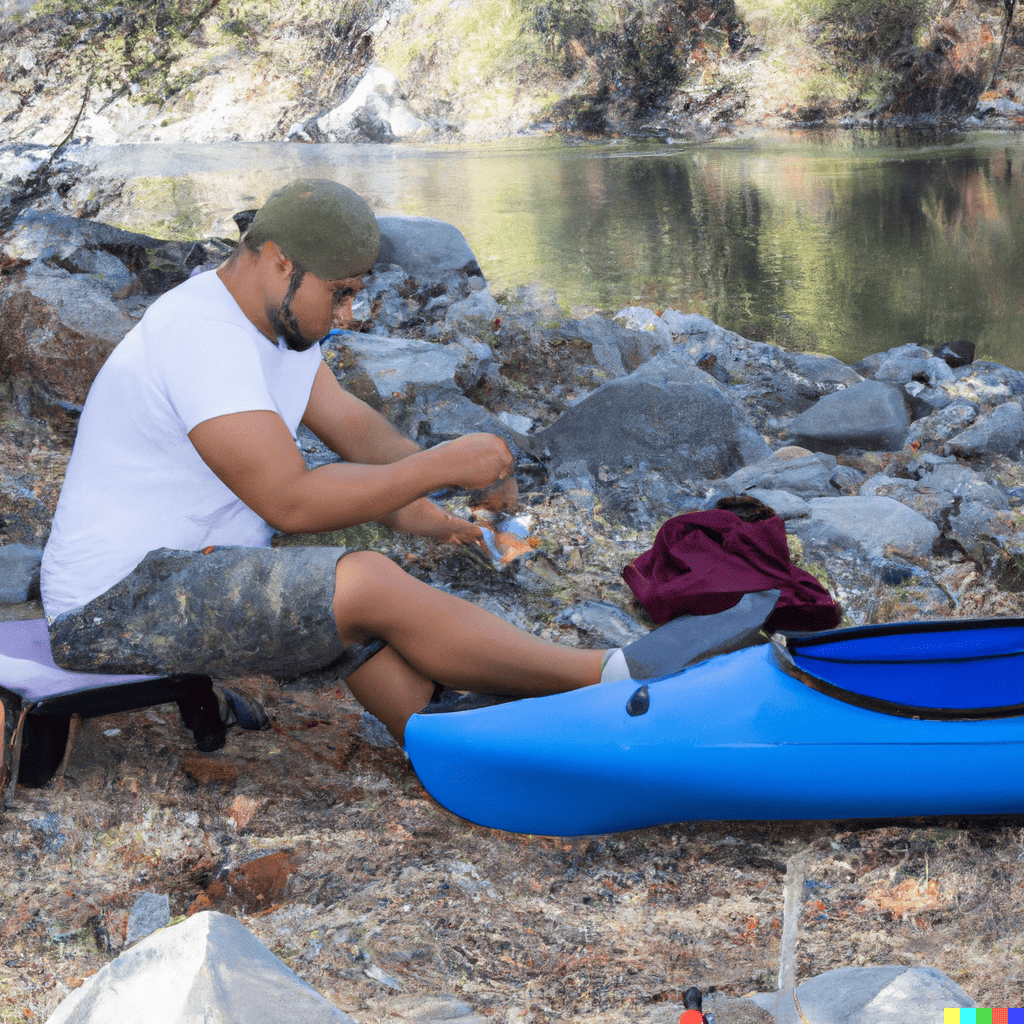
First and foremost, we cannot underestimate the significance of a personal flotation device (PFD) and a rope. These items serve as our lifelines in unexpected emergencies, giving us the peace of mind to enjoy our kayak camping experience. Additionally, carrying a reliable kayak repair kit is an absolute necessity. This invaluable resource equips us with the tools necessary to swiftly address any minor mishaps that may arise, allowing us to swiftly get back on track and prevent potential disruptions to our journey. In addition to safety gear, packing essential navigation tools is equally important. A compass, a trusted companion guiding us in the right direction, is a non-negotiable item in our kit. Pair it with a comprehensive map of the area we intend to explore, and we have the ultimate formula for confident navigation. In this digital age, leveraging technology can further enhance our preparedness. Downloading the map on our phones before the trip ensures that even if we lose our signal amidst the untamed wilderness, we can still rely on our preloaded digital map to find our way. Meticulous preparation is key to unlocking an extraordinary and safe kayak camping experience. By prioritizing including these essential items in our gear list, we can confidently navigate the waterways, fully immerse ourselves in nature’s embrace, and savor every moment of our remarkable adventure.
Effective Packing Strategies
Efficiently organizing and packing our gear for a kayak adventure is an art that can seem like a challenging game of Tetris. However, with a strategic approach and a few expert tips, we can master this essential skill and maximize the storage space in our kayak. Let’s delve into the world of smart packing and discover how to make the most of every inch.
Maximizing Storage Space in Your Kayak
Regarding intelligent packing for a kayak camping gear, several key considerations can help us optimize storage space and ensure a well-balanced load.
Streamlining Your Packing Process
When it comes to efficient packing for outdoor adventures, utilizing color-coded or see-through dry bags can revolutionize locating your items. This simple yet ingenious technique can be a game-changer, saving you time and minimizing the hassle of searching through multiple bags.
Assigning Colors for Easy Identification
You can create a visual system that simplifies your packing process by assigning specific colors to different gear categories, such as clothing, food, and camping essentials. Imagine the convenience of instantly recognizing which bag contains your rain gear, which one holds your snacks, and which one houses your sleeping essentials. No more rummaging through countless bags or mistakenly unpacking the wrong items. With color-coded dry bags, everything becomes easily identifiable and easily accessible.
Enhancing Organization and Efficiency
The benefits of color-coded or see-through dry bags extend beyond easy identification. They also promote organization and efficiency. By dedicating each bag to a specific category, you create a natural order within your gear. You can allocate one bag for cooking utensils and food supplies, another for clothing and personal items, and yet another for your camping equipment. This systematic approach ensures that everything has its designated place, allowing for a well-organized and clutter-free packing experience.
Simplifying Group Trips
Color-coded dry bags are precious during group trips or when sharing gear with others. Assigning a unique color to each participant or group member ensures that everyone’s belongings remain easily distinguishable. This eliminates confusion and makes distributing and retrieving individual gear effortless without mixing them up. Whether you’re on a family outing, a team adventure, or a group excursion, color coding can foster harmony and smooth coordination among all participants.
Some of the best kayaking camping trips can be found in kayak camping Michigan or even with kayak camping Tennessee will hold memories for a lifetime. Gather your group and head to the water.
Ensuring Quick Access and Peace of Mind
Another advantage of using color-coded or see-through dry bags is easy access to specific items. When you need to locate something quickly, you can zero in on the relevant color without wasting precious time. This proves particularly helpful when unexpected weather changes call for immediate access to rain gear or when hunger strikes and you must find your snacks promptly. By streamlining your search process, you can focus on enjoying your outdoor activities and have peace of mind knowing that your essentials are just a glance away.
Color-coded or see-through dry bags are a small investment that can yield significant benefits in terms of convenience, organization, and efficiency. They add a touch of simplicity to your packing routine and enhance your overall outdoor experience. So, next time you gear up for an adventure, consider implementing this game-changing packing strategy and enjoy its ease and satisfaction.
Balancing Weight for a Smooth Ride
Understanding the center of gravity.
The center of gravity is a crucial concept to grasp when maintaining stability in your kayak . It refers to the point where the kayak’s weight and contents are evenly distributed, allowing for a harmonious equilibrium on the water. In most kayaks, the center of gravity is near your feet, so it’s essential to focus on this area when organizing your gear.
Importance of Weight Distribution
Distributing weight evenly in the kayak serves multiple purposes. Firstly, it helps prevent the kayak from becoming imbalanced, reducing the risk of tipping or capsizing. Secondly, it enhances maneuverability by maintaining a neutral position for smooth turns and agile movements. Lastly, it contributes to your overall comfort during the paddling journey, as an unbalanced load can cause strain on your body and affect your posture.
Strategic Packing Tips
To achieve a well-balanced kayak, consider the following packing tips:
- Heavier Items at the Center: Place the heavier items closer to the kayak’s center of gravity, near your feet. This could include camping equipment, water containers, or any other dense gear. Doing so ensures that the weight is distributed evenly along the length of the kayak.
- Lighter Items Towards the Ends: Position lighter items towards the ends of the kayak, such as your dry bag with clothing or snacks. This helps maintain stability and prevents the kayak from feeling top-heavy.
- Balance Front to Back: Aim for an even weight distribution from the front to the back of the kayak. Avoid placing too many heavy items in one specific area, as this can create an imbalance and affect maneuverability.
- Side-to-Side Balance: Keep an eye on the side-to-side balance as well. If you have additional gear on one side, try to counterbalance it with similar weight on the opposite side.
By following these strategic packing tips and keeping the principles of weight distribution in mind, you can achieve optimal stability, control, and comfort while paddling your kayak. Remember, a well-balanced kayak leads to a more enjoyable and safer journey on the water.
So, take the time to pack thoughtfully and make adjustments as needed. As you embark on your kayaking adventures, the rewards of a properly balanced kayak will become evident in the smoothness of your ride and the freedom to explore with confidence.
Balancing Weight for Superior Stability
Achieving optimal stability and maneuverability in your kayak relies on careful weight distribution. By strategically placing your items and keeping the heavier ones near the kayak’s center of gravity, you can maintain a well-balanced vessel and enhance your overall paddling experience.
When it comes to loading your kayak, a well-balanced distribution of weight is essential for maintaining stability on the water. By following a few key principles, you can achieve optimal weight distribution and enjoy a smoother and more controlled ride.
Front-to-Back Balance
To maintain proper weight distribution, focus on balancing the load from the front to the back of your kayak. Placing heavier items towards the middle and back of the kayak helps keep the center of gravity aligned and prevents the kayak from becoming front-heavy. This balanced weight distribution promotes stability and improves your ability to maneuver the kayak effectively.
Side-to-Side Equilibrium
In addition to front-to-back balance, it’s important to consider the side-to-side weight distribution. Uneven weight distribution can lead to lopsidedness, affecting the stability and responsiveness of your kayak. To achieve an even distribution, carefully arrange your gear to position similar weights on both sides of the kayak. This equal weight distribution ensures better stability and makes navigating through different water conditions easier.
Considerations for Heavier Items
Heavier items should be placed in areas that contribute to balance and stability. Position them closer to the kayak’s center of gravity, typically near your feet. This placement prevents the kayak from tilting and helps maintain a level orientation. Securing heavier items is advisable to prevent them from shifting during paddling.
Organizing and Securing Gear
To optimize weight distribution and minimize the risk of items shifting or falling overboard, consider using storage compartments, dry bags, and bungee cords. These gear organization tools help keep your equipment secure and contribute to the overall balance of your kayak. It’s also a good practice to frequently check and readjust your gear during breaks to ensure stability throughout your journey.
By paying attention to both front-to-back balance and side-to-side equilibrium, you can achieve the optimal weight distribution in your kayak. This promotes stability, enhances maneuverability, and allows for a more enjoyable paddling experience.
Always double-check your gear placement and make necessary adjustments before setting off. With a properly balanced load, you’ll have the confidence to navigate various water conditions and fully immerse yourself in the beauty of kayaking.
So, take the time to organize and distribute your gear thoughtfully. Your efforts will be rewarded with enhanced stability, better control, and a more comfortable adventure on the water.
Embracing Versatility: Packing for Changing Weather
When setting out on a thrilling kayak camping expedition, being prepared for varying weather conditions is key to ensuring a comfortable and enjoyable journey. By packing versatile clothing and gear that can adapt to a wide range of temperatures and precipitation, you can confidently tackle whatever Mother Nature throws your way. Let’s delve deeper into some valuable tips for packing for different weather scenarios during your kayak camping adventure.
Mother Nature can be unpredictable, but with the right gear, you’ll be ready to face any weather conditions during your kayak camping trip. Here’s how you can effectively pack for varying temperatures and precipitation:
Layering for Ultimate Adaptability
Layering is a tried-and-true strategy for outdoor enthusiasts, and it holds true for kayak campers as well. By wearing multiple layers, you can easily adjust your attire to accommodate changing weather conditions throughout the day. Here’s a breakdown of essential layers to consider:
- Base Layer : Start with a moisture-wicking base layer that keeps you dry by drawing sweat away from your body. Look for materials like merino wool or synthetic fabrics designed for active wear.
- Insulating Layer : Add an insulating layer to trap warmth. Fleece jackets or lightweight down vests are excellent choices. They provide warmth without compromising mobility.
- Shell Layer : A waterproof and breathable outer shell is crucial for protecting yourself against rain, wind, and spray. Invest in a high-quality rain jacket and pants that can withstand the elements while allowing moisture to escape.
Adaptable Clothing and Gear
Versatile clothing and gear are essential when you can’t predict exactly what the weather will bring. Consider the following items to ensure you’re well-prepared:
- Convertible Pants : Opt for pants that can be converted into shorts using zip-off legs. They offer flexibility for changing weather conditions and varying levels of activity.
- Synthetic or Merino Wool Socks : Choose moisture-wicking socks that keep your feet dry and comfortable throughout the day. Synthetic or merino wool options are ideal for their breathability and quick-drying properties.
- Insulated Jacket : Pack a lightweight, packable insulated jacket to provide additional warmth during chilly evenings or unexpected temperature drops.
- Rain Gear : Along with a reliable rain jacket and pants, bring waterproof gloves and a waterproof hat to shield yourself from rain or spray.
Essential Accessories
Don’t forget to pack these essential accessories to enhance your comfort and protect yourself from the elements:
- Wide-Brimmed Hat : A wide-brimmed hat provides protection from the sun’s rays during hot, sunny days and offers some shielding from rain when needed.
- Buff or Neck Gaiter : A versatile and lightweight accessory that can be worn as a neck warmer, face mask, or headband, protecting against wind, sun, and bugs.
- Sunglasses : Wear polarized sunglasses to protect your eyes from harmful UV rays and glare. They improve visibility and reduce eye strain while paddling under bright sunlight.
Remember to check the weather forecast before your trip and make any necessary adjustments to your packing list. Flexibility and adaptability are key when it comes to preparing for changing weather conditions during your kayak camping adventure.
By incorporating versatile clothing layers, adaptable gear, and essential accessories, you’ll be ready to face any weather challenges that come your way. Embrace the elements and revel in the joy of kayaking, knowing you’re equipped to handle whatever nature has in store.
Easy Access to Essentials: Convenience at Your Fingertips
To ensure a seamless and organized kayak adventure, it’s essential to incorporate smart strategies that optimize gear accessibility and storage space. By implementing the following techniques, we can conquer the challenge of organizing our gear and embark on our kayak journey fully prepared and ready for anything nature has in store.
Having quick access to frequently needed items can make all the difference when out on the water. By storing essentials like a water bottle, map, and first aid kit in easily accessible compartments, you can avoid the hassle of rummaging through your packed gear. Consider the following options:
- Waterproof Compartments : Utilize dedicated waterproof compartments in your kayak to securely store essential items. These compartments keep your gear dry and easily reachable, providing convenience and peace of mind.
- Convenient Fanny Pack : Opt for a lightweight and water-resistant fanny pack that can be worn around your waist. This allows you to keep important items close at hand without the need to search through your larger bags. It’s a practical solution for frequently storing items you may need during your kayak adventure .
Elevating the Art of Smart Packing: Strategies for Success
By implementing the following strategies, you can optimize storage space, maintain balance, and ensure a well-organized kayak journey:
1. Color-Coded or See-Through Dry Bags
Using color-coded or see-through dry bags is a game-changer when it comes to locating items quickly and efficiently. Assign specific colors to different gear categories, such as clothing, food, and camping essentials. This organizational system streamlines the packing process and eliminates the frustration of rummaging through multiple bags.
2. Even Weight Distribution
Maintaining stability and maneuverability on the water requires even weight distribution in your kayak. Keep heavier items closer to the kayak’s center of gravity, typically near your feet. This prevents the kayak from becoming imbalanced and ensures a smoother paddling experience.
3. Proper Balance for Stability
Balancing the load from front to back and side to side is crucial for optimal stability. Pack heavier items in the middle and towards the back of the kayak while also distributing weight evenly on both sides. This prevents lopsidedness and improves maneuverability, allowing you to paddle with confidence.
4. Versatile Clothing and Gear
When packing for your kayak adventure, choose versatile clothing and gear that can adapt to weather conditions. Opt for clothing that can be layered, allowing you to adjust your attire as the weather changes throughout the day. This ensures comfort and flexibility during your journey.
Embracing the Journey: Ready for New Horizons
With these smart packing strategies and organizational techniques, we can elevate our kayak adventures to new heights. A well-organized and efficiently packed kayak sets the stage for memorable journeys filled with peace of mind and a sense of readiness. So, let’s seize the opportunity to explore the open water, paddle forth confidently, and embark on unforgettable kayak adventures that connect us with the beauty of nature. The water awaits – let’s embrace the journey and let our kayak adventures unfold!
Frequently Asked Questions
What are some safety precautions to take while kayak camping”.
“When we’re kayak camping, safety is our top priority. We always prepare for weather changes by checking forecasts and packing appropriate gear. In case of emergency, we carry devices like whistles and flares for signaling help. It’s also crucial to have a first aid kit, including items like a multitool and bear spray if we’re in bear country. Above all, we respect the ‘Leave No Trace’ principles to ensure we’re preserving the beauty and integrity of our environment.”
How can I effectively manage food and water supplies during a kayak camping trip?”
Ever thought about managing food and water on a kayak camping trip? Let’s dive in. For food, we use preservation methods like vacuum sealing, dehydrating, and using canned goods. It’s all about packing lightweight, non-perishable items. For water, we rely on filtration techniques. We carry a portable water filter, purifying tablets, or a UV light pen. Remember, it’s not just about surviving, it’s about enjoying the journey together.”

What potential challenges or difficulties might I encounter during my first kayak camping trip and how can I overcome them?”
Weather challenges can be a potential difficulty on your first kayak camping trip. Always check the forecast and prepare for sudden changes. Gear selection is also key – ensure you have the right equipment for your needs. We’ve found dry bags, a sturdy kayak, and a reliable tent are essentials. Remember, we’re in this together, learning from each experience. Don’t worry, with careful planning and preparation, you’ll overcome these challenges and have an unforgettable adventure.”
What are some tips for maintaining personal hygiene during a kayak camping trip?”
“Did you know 65% of campers agree that hygiene affects their camping experience? For kayak camping, we’ve got great tips. Consider using solar showers; they’re efficient and eco-friendly. Opt for portable toiletries, they save space and are easy to carry. Don’t forget biodegradable soap and wet wipes for quick clean-ups. Remember, we’re all in this together; maintaining hygiene ensures a pleasant trip for everyone!”
What kind of clothing is most suitable for a kayak camping trip?”
“We recommend clothing that offers weather adaptability for kayak camping. Layering techniques are key; start with swimwear, then add a SPF shirt, and a puffy jacket for cooler weather. Don’t forget water shoes, sandals for wading, and a hat and sunglasses for sun protection. Clothing should be versatile to handle changes in weather and activity. It’s all about being prepared while feeling comfortable and connected with the great outdoors.”
Similar Posts
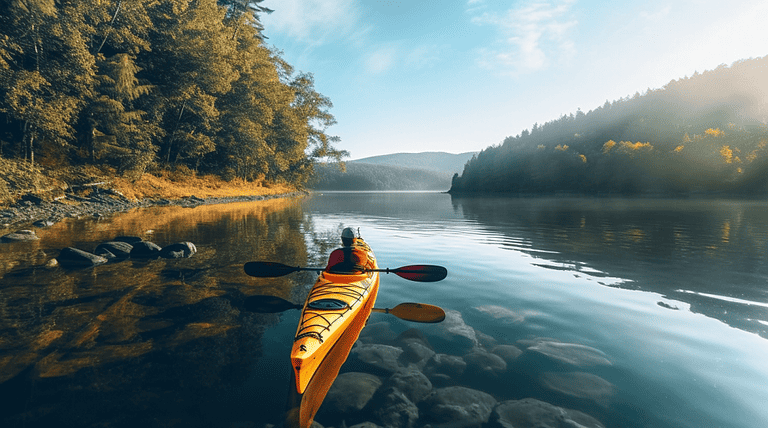
Kayaking 101 For Beginners
Learn the basics of kayaking 101 for beginners. Perfect for first-timers!
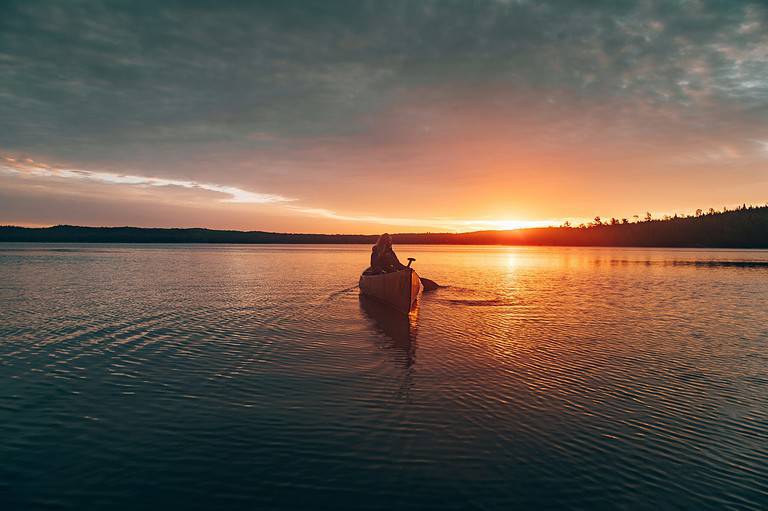
Master Kayaking Anchoring: Pro Tips for Stability & Adventure
Revolutionize Kayaking Anchoring: Enhance Stability, Reduce Fatigue, and Maximize Adventure with a Claw Anchor!
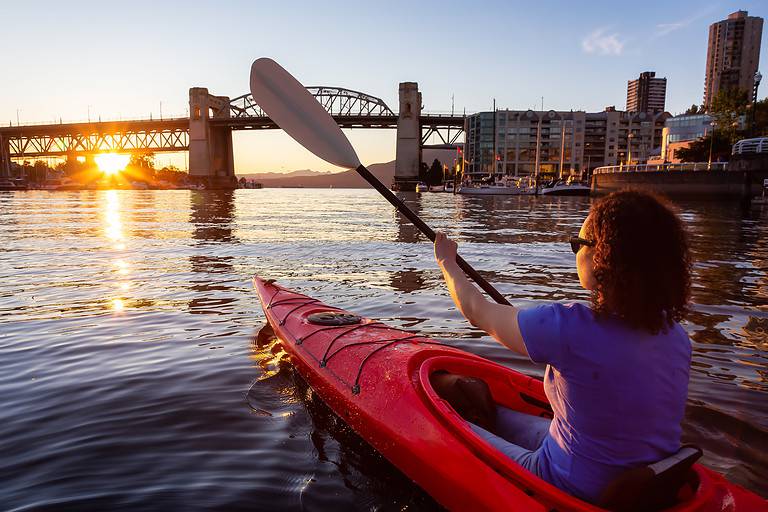
What to Know about Urban Kayaking
Dive into the thrilling world of urban kayaking with our latest blog post! Navigate city waterways, discover hidden gems, and experience the metropolis like never before. Your next city adventure starts here!
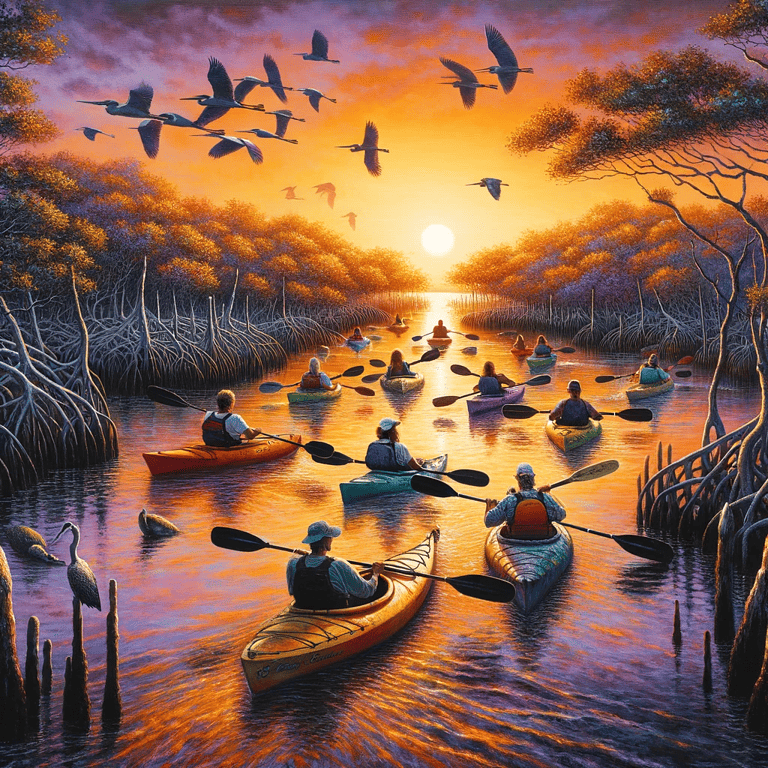
Guided Wildlife Kayaking Journeys in West Florida
Guided Wildlife Kayaking Journeys
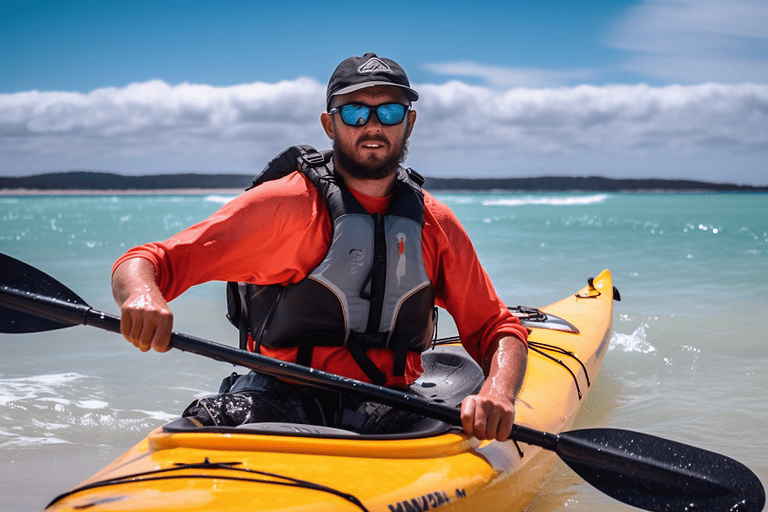
Beginner’s Guide To Sea Kayaking
Learn the basics Beginner’s Guide To Sea Kayaking. Get ready to explore the open waters!
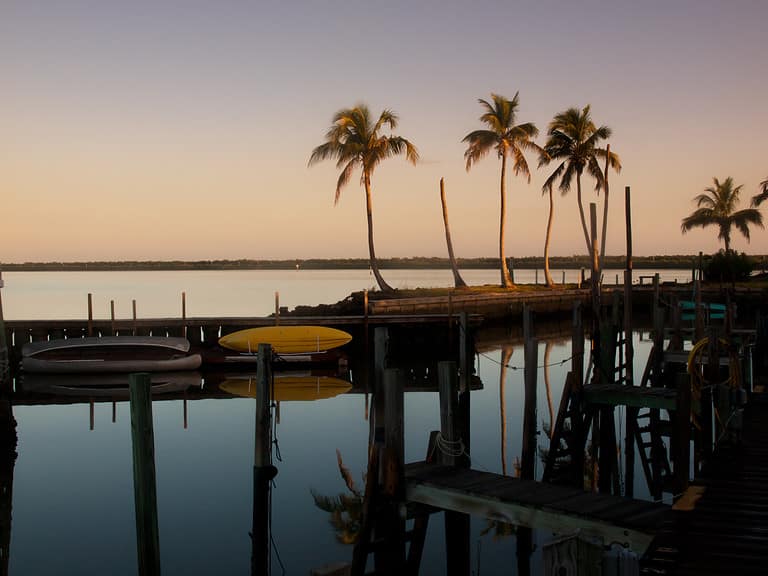
The Best of Key Largo Kayaking And Snorkeling National Marine Sanctuary
Key Largo Kayaking: Discover the unparalleled beauty of Key Largo’s National Marine Sanctuary. Dive into a world of vibrant marine life with our top kayaking and snorkeling adventures. Experience the best of underwater wonders in Key Largo

- Gear Directory
- Multihull Sailor
- Boats for Sale
- Real Estate
- Maintenance & Hardware
- Water Sports
Kayak Camping: A Beginner’s Guide and Packing List
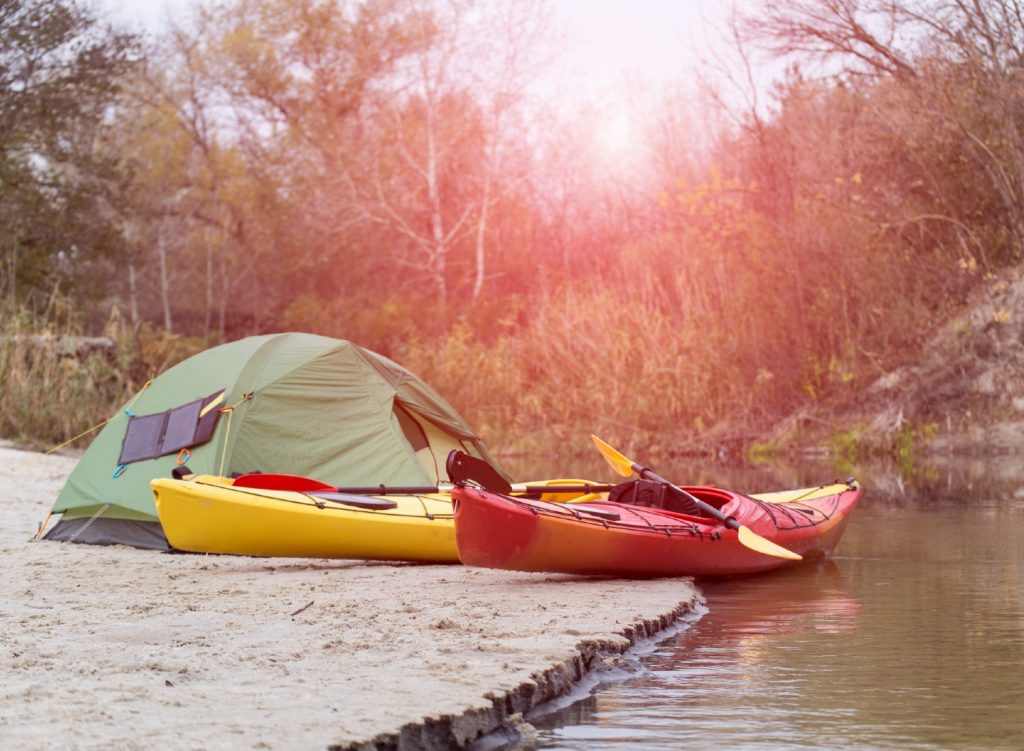
- 1 What is Kayak Camping?
- 2 Planning Your Kayak Camping Trip
- 3 Choose a suitable location
- 4 Check the weather forecast
- 5 Research campsites
- 6 Plan your route
- 7 Get the necessary permits
- 8 Essential Gear for Kayak Camping
- 9 Kayaking Gear
- 10 Camping Gear
- 11 Additional Tips and Tricks
- 12 Conclusion
Related Posts
If you love the great outdoors but are tired of traditional camping, why not try kayak camping? This exciting activity combines the best of both worlds—exploring picturesque waterways while also spending a night in the wilderness.
But if you’ve never been kayak camping before, it can seem like an overwhelming task. Where do you start? What gear do you need? Don’t worry, we’ve got you covered. In this guide, we’ll walk you through everything you need to know to plan and pack for your first kayak camping adventure.
What is Kayak Camping?
Kayak camping, also known as kayak touring or sea kayaking, involves traveling and camping by kayak. In simple terms, it’s like backpacking on water. Instead of hiking with a heavy pack on your back, you’ll be paddling with all your gear stowed in your kayak.
Kayak camping allows you to access secluded campsites that are only reachable by water. It also gives you a unique perspective of the surrounding nature, as you’ll be gliding quietly along the water, away from busy roads and hiking trails.
Planning Your Kayak Camping Trip
Before you start packing your gear, it’s important to plan your kayak camping trip properly. Here are some things to consider:
Choose a suitable location
When picking a destination for your first kayak camping trip, choose an area with calm waters and beginner-friendly conditions. Rivers, lakes, and coastal areas are great options.
Check the weather forecast
Weather plays a crucial role in any outdoor activity. Check the forecast before you head out and be prepared to change your plans if necessary.
Research campsites
Look for designated kayak camping sites in your chosen location. These will usually have amenities such as toilets and fire pits, making your trip more comfortable.
Plan your route
How long do you want to paddle each day? Are there any potential hazards or portages along the way? Plan out your route before you leave so that you know what to expect.
Get the necessary permits
Some kayak camping locations may require permits. Make sure you have all the necessary paperwork before you set off.
Essential Gear for Kayak Camping
Packing for a kayak camping trip can be challenging, as space is limited and weight is a concern. Here are some essential items that every beginner should bring on their first trip:
Kayaking Gear
- Kayak : The most important piece of gear. You can either buy or rent a kayak, but make sure it’s suitable for your skill level and the type of water you’ll be paddling on.
- Paddle : Your kayak paddle should be lightweight and easy to grip. Make sure it’s the right size for you, as using a paddle that’s too long or short can make paddling more difficult.
- Lifejacket : You should never go kayaking without a lifejacket. Look for one with a comfortable fit and enough buoyancy to keep you afloat in case of an emergency.
- Spray skirt (optional) : If you’re kayaking on rougher waters, a kayak spray skirt can protect you from getting wet. However, it’s not necessary for calmer conditions.
Camping Gear
- Tent : You’ll need a tent that is compact and easy to set up since space is limited on your kayak. A backpacking or lightweight tent works well for kayak camping.
- Sleeping gear : A sleeping bag and sleeping pad will keep you warm and comfortable while sleeping on the ground.
- Cooking equipment : Don’t forget to bring a small stove, fuel, and cooking utensils. You can also pack dehydrated meals or easy-to-cook foods like pasta for quick and convenient meals.
- Clothing : Pack clothes that are suitable for the weather conditions of your chosen location. It’s best to bring layers, as temperatures can change quickly when you’re out on the water.
- Waterproof bags : To keep your gear dry, pack it in waterproof bags or dry bags. These are essential for any kayak camping trip.
Additional Tips and Tricks
Here are some additional tips to help ensure a successful and enjoyable kayak camping trip:
- Keep safety in mind at all times. Wear your lifejacket , stay hydrated, stay close to shore, and avoid paddling in risky conditions.
- Check the weight capacity of your kayak before packing. Overloading your kayak can make it unstable and difficult to paddle.
- Opt for a fishing kayak if you enjoy fishing. It’s a great way to relax while camping on the water.
- Don’t forget to pack a first-aid kit and know how to use it.
- Leave no trace. Make sure you bring all your garbage with you and leave the campsite as clean as you found it.
Kayak camping is an exciting way to experience the great outdoors. With proper planning and essential gear, even beginners can enjoy this unique adventure. So why not give it a try on your next camping trip? You might just fall in love with the tranquility and beauty of kayak camping.
Article Contributors
Sail magazine review team.
SAIL Magazine Review Team reports on best-selling products in sailing and boating. SAIL Magazine is reader-supported: When you buy through links on our site, we may earn an affiliate commission. Artificial Intelligence (large language models) may have been used in the research and creation of the content.
To ensure questions about product testing or a specific article are addressed, please contact [email protected]
How To Plan A Kayak Camping Trip – Planning, Packing And Gear Tips!
March 14, 2024
Founder, Kayaking & Paddle Boarding Expert
Sam is the founder and editor of WaterSportsWhiz. With over 20 years of experience across various water sports, he provides trusted reviews and expert advice to help others pursue their passion for getting out on the water. When not working, you can find him kayaking, paddle boarding, or planning his next water-based adventure with family and friends.
Reviewed by: Nessa Hopkins
Nessa Hopkins
ACA-Certified Kayaking Instructor
Vanessa is a certified kayaking instructor, has taught over 500 people how to kayak, and is a senior member of the American Canoe Association. By combining her deep understanding of the sport and a background in journalism, she offers a wealth of experience and expertise to our growing water sports community, promising to educate and inspire paddlers of all levels.
Read Our Editorial Guidelines

For first-time kayak campers, the appeal is obvious. Paddling through breathtaking scenery by day and sleeping under the stars at night. Yet the key to making this outdoor vision a reality is thoughtful preparation. Without proper planning, your trip could quickly sink from paradise to disappointment.
The good news? With smart planning, your kayaking camping adventure can be fun, safe, and hassle-free.
This guide includes pro tips on critical factors like
- Choosing a beginner-friendly location.
- Planning your route and daily mileage.
- What to look for when selecting a campsite.
- A packing list of the essential gear you should bring.
- Tips for loading gear securely and balancing weight in your kayak.
Follow our step-by-step advice for planning every aspect of your journey. We’ll have you outfitted and kayak camping in no time! Let’s start by discussing how to pick the ideal location.
Key Takeaways
- When choosing a location, pick somewhere close to home with calm waters. Consider paddle-in campgrounds or established kayaking routes.
- Plan your route by estimating realistic daily mileage limits, allowing time for breaks, noting portage sections, and arranging transportation back. Share your float plan.
- Pick campsites with natural shelter, clear tent grounds, legal fire pits, and good boat access. Arrive with enough daylight to get settled before dark.
- Pack essential shelter, safety, hygiene, food, and cooking items only. Use dry bags to keep gear dry. Pack light, balanced and secure the load. Keep frequently used items accessible at times.
- Load gear evenly in your kayak and conduct test runs to improve weight distribution before hitting the water.
- Secure your kayak near shore/high tide lines when camping. Use locks, sand anchors, ropes to prevent drifting.
Planning Your First Trip

Thorough preparation is key to ensuring your kayak camping trip goes smoothly. This section will cover the basics – choosing a suitable location, picking beginner-friendly routes, researching camping spots and weather conditions, mapping your daily mileage, being aware of potential hazards, arranging transportation, and more.
Follow these kayak camping trip planning steps and tips to set yourself up for the best first-time experience.
Choosing A Beginner-Friendly Location
The choice of location can practically make or break the entire trip. When selecting a spot for your first kayak camping trip, keep things simple and familiar. Stay close to home within a 100-mile radius or 2 hour drive . This allows more time for the fun parts – paddling and camping – rather than excessive driving.
For new paddlers, I recommend limiting your kayak trip to just one or two days , which means you won’t need to carry loads of gear, helping to reduce weight – making paddling easier.
Keep your daily mileage to 8-10 miles on calm, slow-moving waters without strong currents or steep slopes. Don’t take on too many challenges early on that could cut the trip short. You’ll still find plenty of adventure at this relaxed pace.
Don’t burn yourself out on your first try.
Pick popular, well-traveled kayaking routes across the country, such as boundary waters or river trails through state/national parks, you will find many have paddle-in campgrounds. Plus, on these established waterways, you’re likely to encounter more seasoned paddlers happy to lend navigation advice for newcomers.
If you’re still a bit hesitant about your skills, opt for guided tour groups your first time out. Knowledgeable guides choose routes with kayaker checkpoints, designated campsites, and provide everything you need for a smooth intro to camping and kayaking.
While we’re at it, I’d recommend the following destinations:
- Boundary Waters Canoe Area Wilderness
- French Broad River Trail, North Carolina
- San Juan Islands, Washington
- The Youghiogheny River Lake
- Everglades National Park
- The Colorado River
- The Mississippi River
- Kenai fjords national park
Picking The Perfect Camping Spot

Now, camping is the second – but equally important – part of this equation.
Selecting a top-notch overnight camping spot is nearly as important as mapping your paddling route. After all, you’ll want to spend evenings and mornings resting in comfort before hitting the water again.
Here are some of the key things to look for when evaluating potential campsites;
- Natural Shelter – Seek sites tucked within tree cover or rock formations blocking prevalent winds and weather. Shade also provides relief on hot sunny days.
- Legal fire pits – Designated safe spots for campfires if cooking meals. Check rules allow gathering firewood.
- Cleared tent grounds – Flat, dry areas to pitch your tent, free from rocks/roots/debris
- Proximity to water – Quick access to easily launch/land kayaks
- Secure boat access – Docks, posts or storage to safely secure kayaks overnight
- Parking nearby – Convenient vehicle access for drop offs/pickups.
- Animal Precautions – Bear boxes on premises let you stow food away from tent sites.
- Facilities -Bathrooms/restroom facilities as available
- Natural wind barriers – Landscape blocking heavy winds makes tents less vulnerable
Make sure to allow yourself enough time to find perfect the campsite and get the tent set up before the dark. And try to be as generous as you can – even experienced paddlers encounter some unplanned delays.
Useful resources for finding established campsites along kayak routes include:
- Recreation.gov campground locator
- Individual state park websites
- Paddle-specific apps like Pactola or GoPaddling
Check the Weather Forecast

The other thing you need to take into consideration is the weather .
Kayaking conditions can change dramatically with the weather. Storms, high winds, intense sun, or sudden temperature drops can quickly transform a pleasant trip into an endurance test. After all, I am sure you would prefer not to be paddling headfirst into storms or enduring hypothermic nights shivering in your tent?!
I suggest regularly checking both short and long range forecasts across multiple sources leading up to your trip. If heavy storms, high winds or severe temperature swings threaten any part of your planned timeline, strongly consider postponing. Safety first!
Factor likely conditions into your gear packing strategy too. Sunny skies? Don’t forget sunscreen and a hat. Chilly or wet? Make room for extra layers and a waterproof jacket/pants.
And of course, hope for the best but pack for the worst !
Map Out Your Daily Route & Mileage In Advance

When deciding on your daily mileage, keep in mind that the average paddling pace is approximately 2 miles per hour, although currents can affect your speed. It is advisable for beginners to limit their distances to 8-10 miles per day.
While this may not sound like a great distance on paper, trust me when I say that 4 to 5 hours of paddling is sufficient, even for the most physically fit individuals.
I always recommend mapping the entire end-to-end journey before departure using tools like Google Earth. This allows you to identify potential rest stops, take notes on any sections that require portage, and ensure you arrive at your campsite before dark. It is also important to have an alternative route (Plan B ) in case of any unexpected circumstances.
Researching parts of the water that present challenges, such as swift currents and known underwater obstacles like low-head dams or strainers , is crucial for being prepared. By doing so, you can avoid being caught off guard and ensure that you are paddling within the abilities of yourself and your group.
Be generous with breaks too— multiple short stops prevent exhaustion better than a few long ones. Leave wiggle room for the unexpected too. Building in flexibility for extended lunches, sore muscles, or unplanned detours will prevent rushed travel days. Here’s to meandering when the mood strikes!
Also, be a responsible paddler and file your float plan with someone you trust – you never know what problems can jump at you when you finally hit the water.
Don’t Get Stranded: Arrange Logistics
When planning your kayak overnight trip, it’s important to consider transportation arrangements. Unless doing an epic point-to-point or loop paddle, you’ll need to figure out how to get back to your starting point.
The easiest option is to choose an out-and-back route where you launch from a single spot and return to the same place . This way, you can leave your vehicle safely parked while you’re out on the water.
For paddling downstream with a pickup at the take-out, many popular paddle routes offer a convenient shuttle service during the peak season. Just make sure to accurately plan your journey timeline so as not to miss your pick up.
If shuttles aren’t available, consider coordinating return trips with new paddling friends who are also heading off the water. Caravanning not only fosters a sense of community, but also ensures that everyone departs safely. Most fellow river rats, myself included, are more than willing to offer a ride in exchange for gas money and the opportunity to share stories of future trips!
Lastly, if you need to hire transportation to haul your kayak and equipment, reserve rental trucks or trailers well in advance. And don’t forget straps, padding and tie-downs to protect your precious kayak during transit.
Essential Kayak Camping Gear: What To Bring On A Kayak Camping Trip?

When it comes to selecting what to bring on a kayak camping trip, your instincts might tell you the more equipment you bring, the better off you are; I get that. But people tend to go way overboard with this idea.
Packing for a kayak camping trip is an exercise in ruthless efficiency . You’ll need to evaluate each piece of gear not just for utility but for multi-use functionality given tight storage constraints.
Resist the urge to over-pack for unlikely scenarios. Extra “just in case” items often go unused while weighing you down with additional pounds on portages. You only need the bare essentials necessary for survival – meaning food, clothing, essential gadgets and tools, and shelter.
Everything else is a luxury.
Let the guiding minimalist principles be quality over quantity and versatility over specialty when provisioning your adventure. Doing so affords room for transporting memories rather than unused clutter back home.
We’ve compiled a packing list of essential items below;
Shelter, Kayak & Basic Survival Tools
- A kayak with plenty of space – you will need a higher-than-average weight capacity (300lb plus), multiple storage options such as dry hatches, suitable for long-distance paddling – in short, a sit-in or sit-on-top touring kayak .
- A waterproof, lightweight tent. Pick a tent designed for a backpacking trip, as these will be compact and be easy to stow. Look for models with a waterproof floor and rain fly to withstand wet conditions. Also, an insect proof mesh for ventilation and bug prevention. If you’re going for a one-day trip or expect extremely gentle weather, you could get away with a hammock and a tarp.
- Sleeping gear – Consisting of a warm, waterproof sleeping bag that packs down small, an insulated inflatable sleeping pad, and a compact pillow. Look for models specifically designed for backpacking as they are the best choice for this purpose.
- Dry clothing and rain gear . Aside from your trusty drysuit , you should pack dry base layer tops and bottoms, waterproof rain jacket with storm flaps, rain pants or drysuit bottom, lightweight fleece or puffer mid layer, quick-dry socks, waterproof gloves, water shoes with drainage vents and grips . Don’t forget sun protection like UPF shirts, wide brim hats, sunglasses with polarization.
- Power bank, flashlight, and head torch – High-capacity waterproof power bank to recharge devices throughout trip, water-resistant flashlight with extra batteries, hands-free headlamp for setting up camp after dark, also pack a few glow sticks as floating emergency backup lighting.
- Safety Gear – High-decibel whistle, signal mirror, backup map/compass in dry bag. Throw rope, spare paddle. Multi-tool with knife and pliers. Personal locator beacon for SOS signaling. Emergency foil blanket. Duct tape and cord for impromptu repairs.
- Personal hygiene items – eco-friendly body wash, wet wipes, and plenty of toilet paper (preferably safely stored in a dry zip lock bag), along with a first aid kit.
Food & Cooking Equipment
- Camping stove – the lighter you go, the better. Simple outdoor meals don’t require any excessive equipment. Opt for a small, portable propane or isobutane burner, with a windshield to conserve fuel.
- Additional cooking equipment , such as a travel BBQ, essential cooking utensils, washing set, lighter, waterproof match or some other type of fire starter .
- A survival knife and an ax – because the firewood won’t chop itself, would it?
- A compact kayak coole r – Insulated, soft-sided cooler bag, with antimicrobial liner and waterproof zipper seal to keep contents cold, dry, and protected for multi-day trips — able to maintain ice retention for 48-72+ hours.
- Camping-friendly food and drink – Pack high-protein, non-perishable meal options along with snacks and hydration items like: Non-perishable, high-protein options such as tuna/chicken pouches, beef jerky/sticks, powdered protein shakes. Complex carbohydrates like oats, granola, dehydrated pasta. Snacks including dried fruits, nuts, nut butters, meal replacement/protein bars. Precooked dehydrated camping meals just needing boiled water. Electrolyte powder/drink mixes to replenish salts and minerals lost while paddling.
- Water Bottle – To save small use collapsible water containers. Make sure they are durable, leak-proof, BPA-free with an attachable carabiner clip.
- Tea and coffee . These are the best when it comes to getting you warm and kick-starting your day early in the morning. Honestly, I’m absolutely feral without my morning dose of caffeine. I would never dare to leave home without my French press.
- Litter bags – because, well, you don’t want to be that person that leaves a mess behind when they leave the camp. Plus, they can come in useful in other situations, too.
Miscellaneous
- Dry Bags : Like socks, you can never have enough dry bags. dry bags in varying sizes lets you safely stow phone, snacks, clothes with no leaks after splashes or spills. Roll-top closures seal tight. Secure to kayak interior with straps for grab-n-go access.
- Sunscreen: Don’t let cloudy skies deceive you – the sun’s rays reflect intensely off the water. Generously apply water-resistant SPF 30+ sunscreen pre-launch to lock in UV protection through the day. Broad spectrum formulas that block UVA/UVB rays along with zinc oxide provide superior protection for outdoor activities. Zinc oxide physically blocks the sun’s rays rather than absorbing it like other chemicals, which minimizes skin irritation and allergic reactions. It also defends against longer UVA rays that penetrate deeper, making it uniquely suited to extended sunlight exposure kayaking.
- Bug Spray: Mosquitos and insects can sabotage an otherwise peaceful shoreside lunch. Come equipped with a trusty DEET or picaridin spray , especially in hot summer months when bug populations spike. These effective repellents ward off mosquitos, ticks, flies, and other pesky biters. Apply a protective mist generously before heading out and don’t be shy about reapplying after swimming or a few hours of paddling.
You may also be interested in
- Top-Rated Long-Distance Kayaks For Overnight Trips
Tips On How To Pack A Kayak For Camping

Packing a kayak for camping and fitting all of your gear in a way that’s suitable for a long kayak ride is an art form in itself – and definitely a topic worth discussing.
And much like all other success stories in the world, this one starts with a good plan.
Create An Inventory List & Check It Twice
Packing can be a hasty process, and considering all the things I’ve listed above, there is more than a slight chance you’ll forget something. If you don’t have a reminder, that is.
So, here’s my advice:
Create a list of things you’re going to need, record where those items are stored, and highlight the items that still need to be purchased. Then, go over it before hitting the road – or should I say, waters.
Use Dry Bags For Storage

If I can give you one piece of advice, it would be to use dry bags to help protect everything you bring from getting wet – especially in the case of sensitive electric items. You can think of me as the voice from the future, telling you that relying on dry hatches to keep your items dry is not a very good idea – unfortunately I had to learn this the hard, and expensive, way.
I recommend sticking to a mixture of small to medium-sized bags, ranging from 10-40L. Anything bigger will be difficult to stow or could risk putting too much gear and weight in any one place in the kayak.
I personally keep small essentials like my phone, wallet, and keys in a dedicated fanny pack or bum bag . Not only does this type of pack protect them from moisture, it keeps them close and accessible at all times.

Consider color coding bags by gear category, such as toiletries, kitchen items, medical supplies, and more. Additionally, using transparent bags allows for easy identification of what’s side without the need to unroll or open the bags. This simple system greatly simplifies the process of locating the items you need quickly and efficiently.
I once made a rookie mistake of using five plain black dry bags. Finding my headlamp meant a night diving into each one under fading daylight. Lesson learned!
– Sam O’Brien
Pack Light And Don’t Overload Your Kayak
When packing your kayak for a camping trip, try to be brutally honest, and ask yourself:
Do I genuinely need (insert any item) while I’m paddling?
Prioritize necessity over luxury items as you determine your must-haves and nice-to-haves.
I’m not saying you shouldn’t bring anything – I’m guessing you’re not Bear Grylls. But just keep in mind that your ‘yak has a limited weight capacity , exceeding it will affect your kayak’s performance. You’ll need three or four rounds of reduction to finally trim your baggage to a level we could call “optimal.”
To avoid overloading your kayak:
- Weigh yourself plus any other passengers.
- Weigh all camping gear, food, water – everything that will go onboard.
- Combine passenger and cargo weights. Aim to keep this total at least 30% under your kayak’s specified max load rating.
Balance Your Load Evenly

Weight distribution affects the kayak’s stability, handling, and overall performance – in short, it can turn something that should be a casual paddle into a torturous uphill struggle.
So, keep the heavy items, such as food and water, close to the boat’s center of gravity . And evenly distribute lighter cargo, such clothing or sleeping bags, towards the ends – making sure to balance the weight side-to-side.
We recommend doing a test run at home. Place your kayak on a flat surface and load up all your gear as if preparing for the actual trip. This allows you to assess the weight distribution and balance visually ahead of time. If items need rearranging, better to determine that now rather than when already at the water’s edge.
Keep Essentials Within Easy Reach
When organizing the order in which you pack your gear, ask yourself: Which items will I need regularly during the day while out on the water?
The point is, these items will be of no use to you if they are buried beneath the rest of the cargo and you have to stop and dig them out.
Pack items you’ll need to frequently access towards the top layers or in external pouches . This will save you from constantly unpacking gear or digging around searching for essentials like snacks, sunscreen, or navigation tools.
Small personal items like phones, wallets, and keys also deserve dedicated protected storage. Keep them secure yet handy in your life jacket pockets or clip-on chest packs. These portable packs protect valuables from moisture while allowing easy access without impeding movement
Secure The Load

Making sure your load is secure is super important. I mean, you probably don’t want to chase your cargo down the river if you end up capsized.
I learned this the hard way. Losing my sleeping back in the process – don’t be like me
If possible, cargo should be stored inside the vessel. If not, ensure that everything is secured with bungee cords and leases – and safely stored inside lockable hatches and dry bags.
You might want to do a “practice run” on dry land to get the hang of these things.
Frequently Asked Questions
What are the best ways to secure a kayak when camping.
When planning a kayak camping trip, securing your kayak is crucial to ensure its safety and prevent it from drifting away. The best ways to secure a kayak when camping include using a sturdy cable lock to attach your kayak to a tree or another immovable object near the shoreline.
Additionally, you can use sand anchors or heavy rocks to weigh down the kayak if you’re camping on a beach or soft ground. It’s also advisable to pull the kayak well above the high tide line or water’s edge to prevent it from being taken by the water during changes in tide or unexpected rises in water levels.
What Type of Kayak Is Best for Camping?
The type of kayak best for camping often depends on the nature of your trip, including the water conditions and the amount of gear you plan to carry.
T ouring kayaks, with their long, narrow design, are ideal for camping because they offer enhanced stability, ample storage space, and are designed for longer distances in a variety of water conditions.
Sit-on-top kayaks can also be a good choice for warmer climates and calm waters, offering easy access to gear and the ability to get on and off the kayak more easily.
Ultimately, choosing a kayak with enough storage for your camping gear and one that matches your skill level and the water conditions you’ll encounter is key.
Where to Go Kayak Camping?
Deciding where to go kayak camping depends on your experience level, interests, and the landscapes you wish to explore. Popular destinations include national parks with lakes or rivers, coastal areas for sea kayaking, and river systems that offer a mix of calm waters and mild rapids.
Places like the Everglades National Park in Florida, the Boundary Waters Canoe Area Wilderness in Minnesota, and the Apostle Islands National Lakeshore in Wisconsin are renowned for their stunning natural beauty and are well-suited for kayak camping trips.
Researching specific water trails, local regulations, and seasonal conditions is essential in choosing the best destination for your kayak camping adventure.
Meet the Team
Affiliate disclosure.
Privacy Policy
Cookie Policy
Editorial Process
WaterSportsWhiz
2892 N Bellflower Blvd #1026 Long Beach, CA 90815 United States
+1 (562)-283-4796
We use cookies on this site to optimize site functionality and give you the best possible experience. By using this site, you accept our use of cookies. Read Our Policy
© Copyright 2019 - 2024 - WaterSportWhiz.Com

Kayak Camping: Tips for Planning, Packing, & Gear
Learn the best kayak camping tips for beginners including essential kayak camping gear, how to pack a kayak, tips for buying a kayak, & more
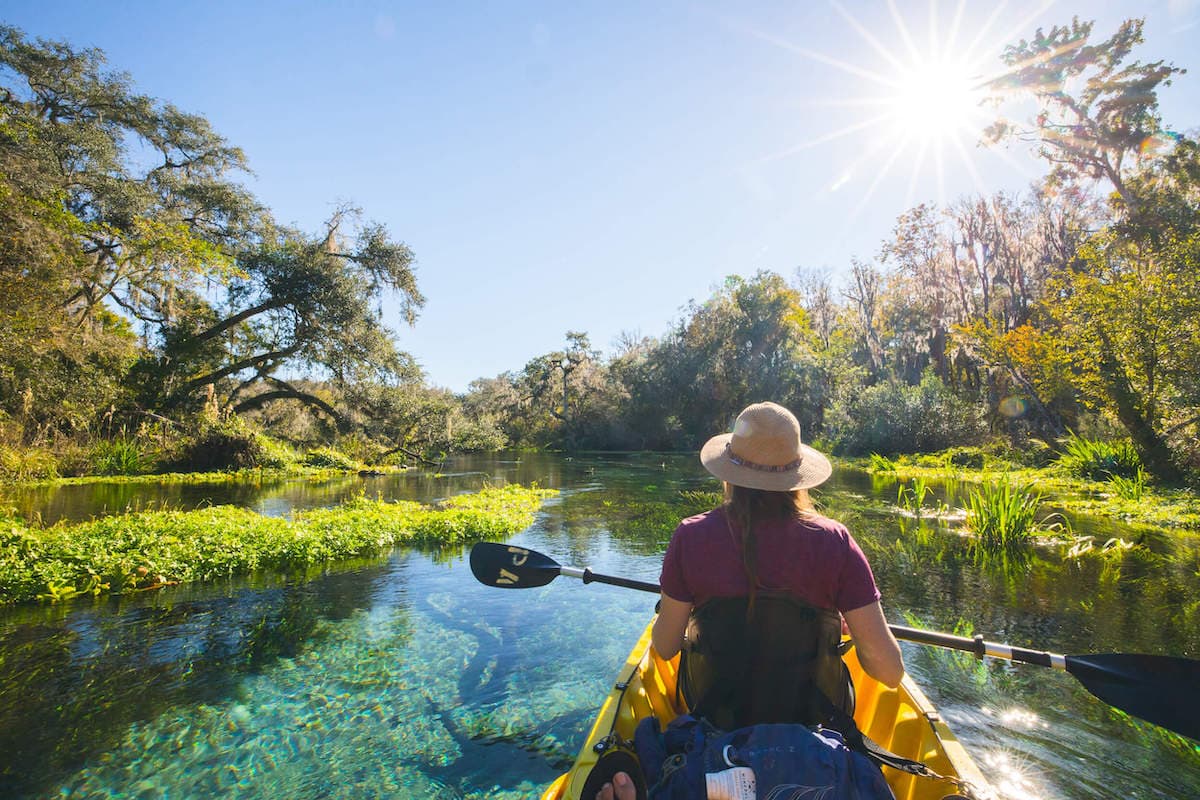
If you love kayaking and you also love backpacking, you should add kayak camping to your adventure list! You’ll not only get to experience backcountry wilderness but also the serenity of being on the open water. One of the best parts of kayak camping is that you don’t have to haul a heavy load on your back for miles on end. You’ll still get a workout as you paddle a boat full of gear, however, plus camping with a kayak gives you more flexibility to take breaks and offers a whole new view, even in areas you’ve already explored.
So whether you’re looking to try kayak camping for the first time or you’re planning your next adventure, this guide will give you tips and advice to help you get out on the water and make the most of your trip.
Here’s our complete guide to kayak camping.
Important Reminder: As outdoor recreationists, it’s our responsibility to know how to recreate responsibly on the water whether we’re kayaking, paddleboarding, canoeing, rafting, or boating. Learn how to prevent the spread of aquatic invasive species with 3 easy steps that have a huge impact on our ecosystems.
How to Choose a Kayak Camping Location
How to choose a kayak, essential kayak camping gear, how to load a kayak for camping.
Selecting your perfect kayak camping location will help you determine how and what to pack. The art of loading a kayak with gear can take some time to perfect, so save the whitewater rapids for another trip and start with more of a calm water destination.
I’d recommend starting with a lake or river that has already established campsites. Keep in mind that if you opt for a river, you’ll likely need an extra vehicle to park at the end of the trip. Plan on sticking to one or two nights for your first excursion. Depending on how experienced you are, anywhere between five to fifteen miles per day should give you plenty of time to paddle and take breaks.
If you decide to hunt out your own site, be sure to set up camp at least 200 feet from the water. Camping in coastal areas offers a chance to see different wildlife, but be sure to take the tides into account when selecting the spot to set up camp.
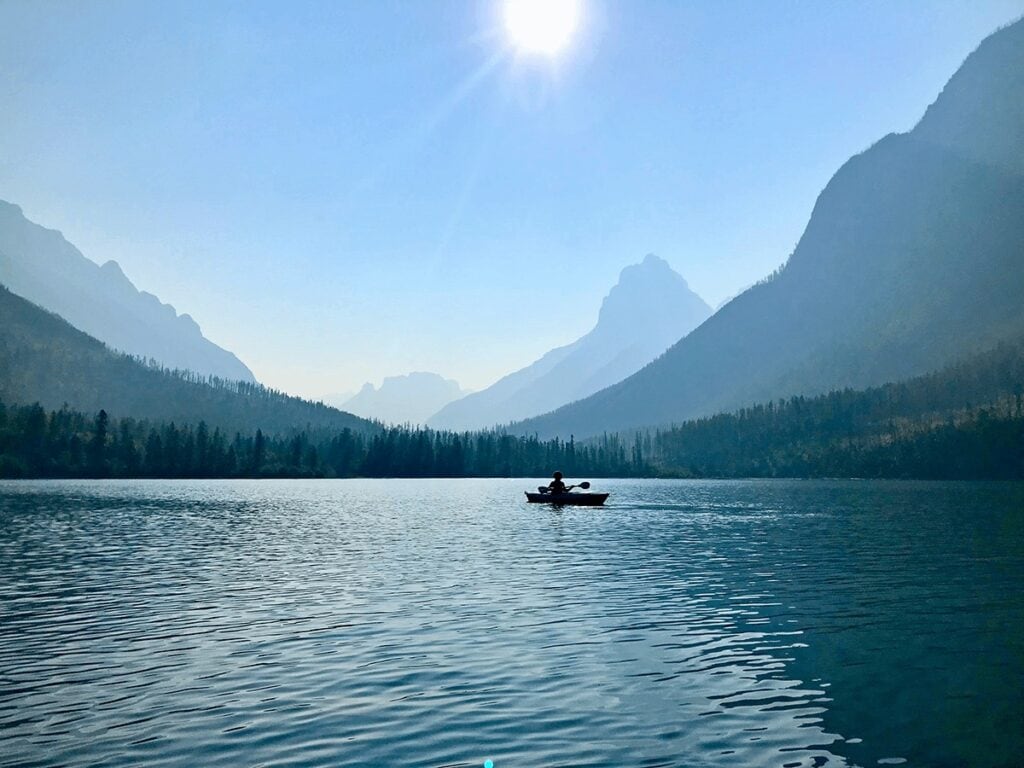
Ultimately, the best kayak for camping is the one you already own. If you plan on renting or investing in a kayak for camping, here are a few things to consider in advance.
- Storage will be crucial to your comfort. You’ll need to store almost everything in dry bags , but having a watertight compartment is a nice feature as well. You can use it to protect valuables like your phone and camera. It’s also a relief to get to camp and have at least some things that are dry. Touring kayaks are typically equipped with these watertight compartments.
- Comfort is a necessity with long days on the water. My primary kayak, similar to this Perception Joyride 10 Kayak , has a supportive seat and foot braces . It also has thigh pads that help with stability. These are all features that will help you paddle for miles with a full kayak. If your seat doesn’t offer enough support, you can install a separate kayak seat to ensure a comfortable trip.
- Comfort isn’t limited to your kayak, however. If your paddle doesn’t have any cushioning, your hands will likely hurt after a day on the water. Adding paddle grips can make a surprising difference in how long you can paddle in a day.

For backpacking enthusiasts, packing for a kayak camping trip will feel familiar. You’ll be bringing most of the same gear, switching out your backpack for a kayak. Since you won’t have to carry all of your gear, you’ll have a little more room for a luxury item or two. Here are some must-bring items:
Kayak Camping Accessories
- Dry bags – Aside from a few accessible items like water and snacks , everything should be packed in dry bags. Even if you’re certain you won’t flip, anything stored on the kayak or in the hull will likely get wet. Dry bags will keep essentials dry and organized. I use several smaller Sea to Summit dry sacks to make packing easier.
- Personal flotation device – Wearing a PFD, or lifejacket, is not only a good safety protocol, but state laws typically require that you have one on board.
- Rope – Bring along a rope to tie up your kayak in case you will leave it close to shore. Paracord is compact and works great.
- Kayak repair kit – A repair kit won’t take up much room and can be a lifesaver if something goes wrong
- Towel – You’ll be living on the water for a few days, so a towel is key. PackTowl’s UltraLite Towels are easy to bring on backcountry trips and work well for how compact they are.
- Binoculars – bring along a pair of binoculars to spot wildlife right from your kayak!
Kayak Camping Gear
- Tent or hammock – Kayak camping offers more flexibility than backpacking, but you’ll still want to use a lightweight backpacking tent or hammock to conserve space and weight. If you’re kayaking in warm climates, you may be fine sleeping under the stars or just bringing the fast-pitch option if your tent has that.
- Sleeping bag – Car camping sleeping bags can be bulky and heavy, so bring along your favorite backpacking sleeping bag .
- Sleeping pad and pillow – A pillow is one of those luxury items I have to bring. Inflatable pillows always have me reaching for some clothes to use instead, so I’m a fan of Therm-a-Rest’s Compressible Pillow when there is room to pack it.
- Headlamp – You’ll need to take extra precaution if you head out on a nighttime paddle, but you’ll also need lighting for around camp. The BioLite headlamp is our favorite because it’s a rechargable, energy efficient LED headlamp that lasts a long time on a charge, especially if you use it on low.
- Small daypack – One of my favorite things about kayak camping is the ability to explore new areas onshore as well. If you think you may want to explore on land, bring along a small daypack for supplies.
Kayak Camping Clothes
- Swimwear – If you’re anything like me, you’ll have a hard time staying out of the water. Investigate the water temperature before your trip if you’d like to swim and then pack accordingly.
- Water shoes or sandals – I can’t say I do any fishing, but I love Columbia’s fishing shoes for all watersports. The PFG Tamiami Shoes have enough grip to traverse wet rocks and are comfortable for camp or heading into town.
- SPF shirt – Most kayaking spots involve a lot of open exposure, so you should plan on getting a lot of sun. Outdoor Research’s Echo line is my favorite to keep cool and protect my skin from harmful sun rays.
- Hat, sunglasses, or both – I go for the combo since the sun reflecting off of the water can be killer. The Wallaroo Sedona hat is a favorite ( Use the code BEARFOOT20 for 20% off ).
- Puffy : kayaking can get chilly, so having a synthetic down jacket packed away is essential so you can stay warm.
Essential Clothing for Paddling
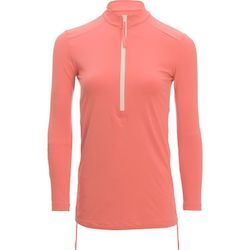
Carve Designs Cruz Rashguard
I prefer wearing a rashguard over sunscreen these days. I own the Cruz in 2 colors and it’s a staple for any water activity because it dries quickly but also keeps you cool, plus the cut is flattering.
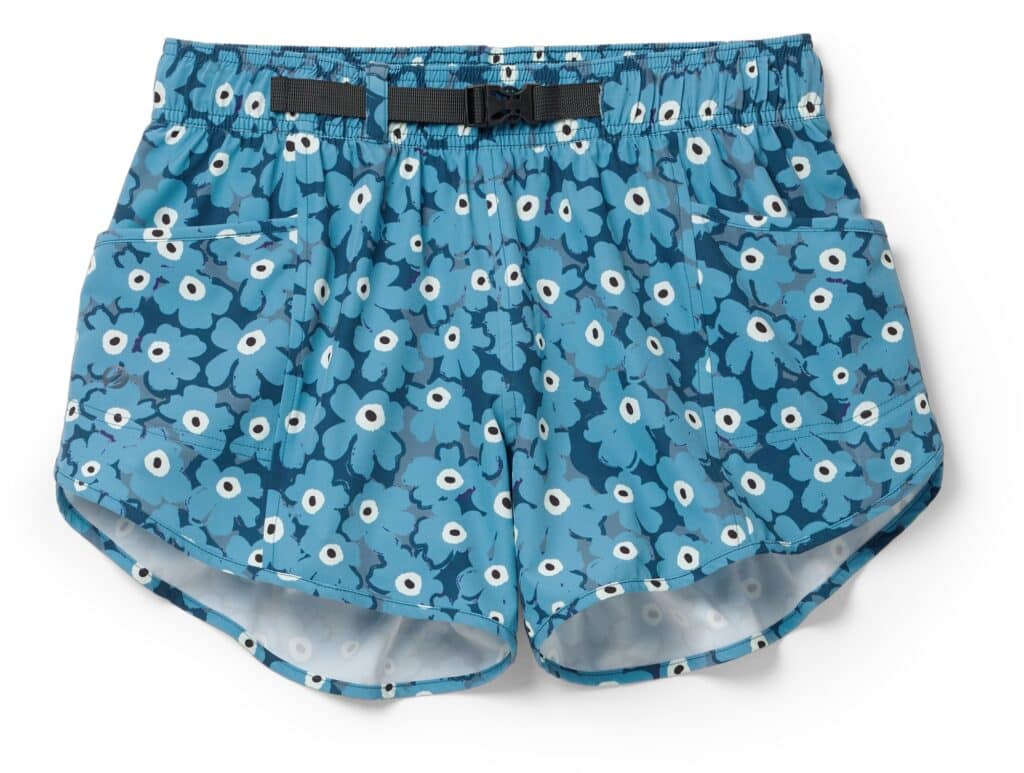
Nani Swimwear Hybrid Explorer Shorts
These shorts are super comfortable, dry really quickly, and come in a bunch of colors and prints. I wear them on all water adventures!

Teva Universal Trail Sandals
Sandals that stay on your feet and can get wet are essential. I like these because they have good grip and can be worn hiking as well, plus they can easily be strapped to your boat when not in use.

Outdoor Research Sunbriolet Hat
You’ll want a wide-brim hat that can get wet and has a chin strap so it stays on in the wind. This Outdoor Research hat is quick-drying, will float if it falls in the water, and comes in a variety of colors.
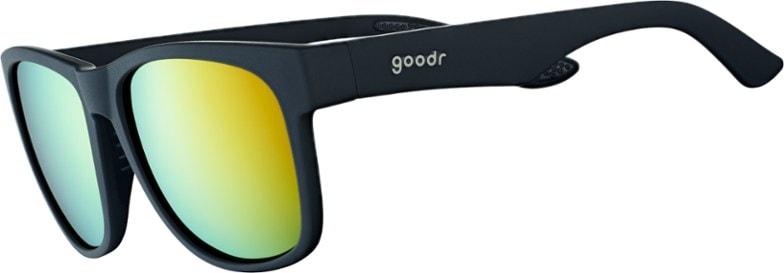
Goodr Polarized Sunglasses
Polarized glasses are best for the reflection of the water. I like to wear budget-friendly sunglasses paddling and I always wear a retainer so I don’t lose them in the water.
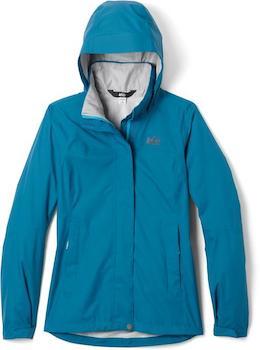
REI Co-op Rainier Rain Jacket
If it’s chilly or windy it can be helpful to have a lightweight rain jacket or windbreaker out on the water with you. I usually pack a jacket like this just in case!
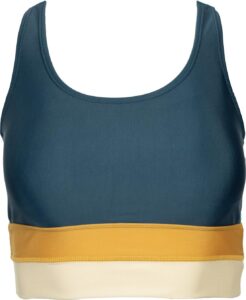
Supportive Swimsuit or Sports Bra
You’ll want a comfortable swimsuit that you can be active in. I like to avoid swimsuits that pull on my neck (like halters) and have been loving Nani Swimwear lately.
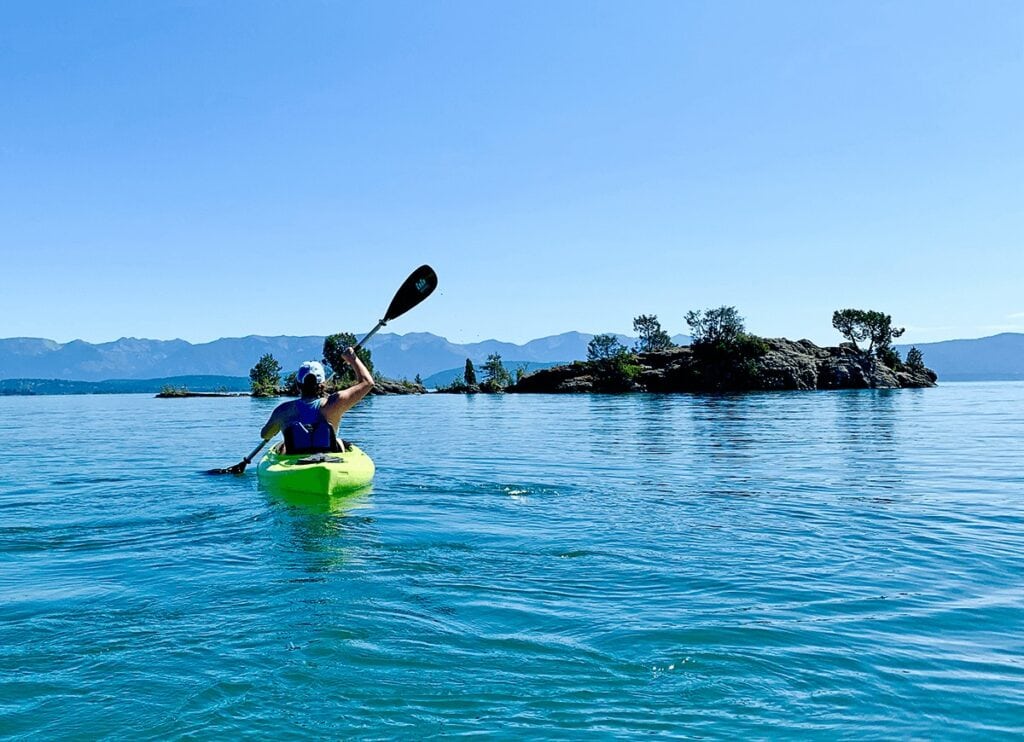
Kayak Camping Kitchen Essentials
- Stove and fuel – You can get away with bringing pre-packaged foods, but the best kayak camping food for me needs to be hot. Camp coffee in the morning is a must as well. I rarely go camping without my Jetboil Flash stove .
- Mug or bowl and utensils – I usually keep it simple with a single mug and spork . If I can’t eat it with those, I don’t need it.
- Food storage – Even if you are not in bear country, you should bring along a separate canister or bag for food with rope. A dry bag is easiest as it’ll offer more storage flexibility in the kayak compared to a canister.
- Food – This is where a lot of people will opt for a luxury item or two. I stick to dehydrated foods , but like to bring along a fancy beverage. I wouldn’t carry the weight of an extra drink on the backpacking trail but will indulge when the kayak is doing all of the work.
- Water bottle – Keep your water bottle handy as it’s easy to get dehydrated when paddling in an exposed area. A Hydroflask is nice as it keeps water cold throughout the trip and is less of a hassle than a bladder.
- Water filtration – I’ve struggled with pump or squeeze filters in the past, so I solely rely on a Platypus GravityWorks filter now.
- Garbage bag – Make sure to clean up after yourself and follow Leave No Trace principles .
Kayak Camping Toiletries & Safety Gear
- Maps – Navigating a lake or river can be a little more difficult than a marked trail. Snag a local map and compass, and download the information on your phone before your trip to keep track of your location.
- Bug spray – Campsites near the water are notorious hotspots for bugs, so bring along some insect repellent to keep the bugs at bay.
- Hygiene kit – Bring along everything that you’ll need for a few days including a toothbrush, toothpaste, sunscreen, SFP lip balm , toilet paper , hand sanitizer , and a poop kit . If the place you are visiting requires you to pack out all of your waste, be sure to bring a few wag bags and dispose of them at the end of your trip.
- First aid kit – Ensure your kit also includes a knife or other multitool along with some matches.
- Bear spray – This is a must if you are heading into bear country
- Emergency communication device – I always carry a Garmin on all outdoor adventures so I can easily call for help in case of emergency. Since many areas of the backcountry don’t have cell service, don’t rely on your phone in case things go sideways.
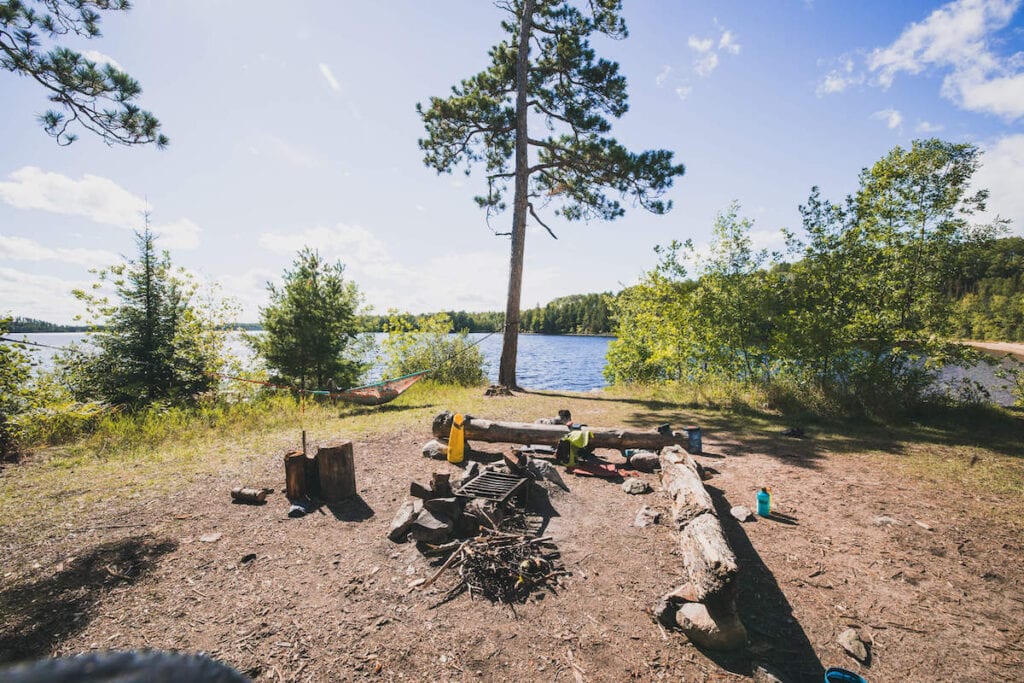
Packing a kayak for camping is a unique form of art. On a typical backpacking trip, you can pack your bag at home so it’s ready to go when you hit the trail. You won’t have that option when it comes to packing your kayak, so you may want to practice at home before your first trip.
Once you’ve gathered all of your gear and are ready to pack, you’ll need to keep three things in mind. You’ll need to pack strategically to ensure everything stays dry, the kayak is balanced, and certain items are easily accessible. Here are a few tips for loading your kayak for camping:
Use Dry Bags
Almost everything you are bringing should be kept in dry bags . It’s easier to get everything to fit in the kayak if you use smaller or medium size bags (like 35-65 L).
If you’re able to color-code them in some way, it will also help you locate items easier. I’ve learned from experience that it is nearly impossible to find anything when all of your dry bags are the same color. Alternatively, see-through dry bags allow you to see all your gear without having to open up every bag.
Know How to Distribute the Weight
To get the right weight distribution, keep the heaviest items like food, water, and fuel closest to your center of gravity . Ideally, your kayak will have space directly behind the seat for some of these items. You can also keep a small bag at the bottom of the boat between your legs if it won’t interfere with paddling.
Then store lighter items, like your sleeping bag and clothes, on either end with mid-weight items somewhere in between. While aiming to balance the kayak from front to back, you should also try to balance the weight from side to side as well. The heaviest items should go in the center.
Keep Your Essentials Accessible
Anything that you won’t need to access through the trip should be stored in a sealed compartment or strapped down in some way. While you of course don’t want to flip, everything should be secured in case it happens.
A waterproof fanny pack is a great way to keep your gear (like phone, sunscreen, compact camera, etc…) easily accessible while still being able to keep everything waterproof and secure. You may also want to keep another layer of clothes handy as well.
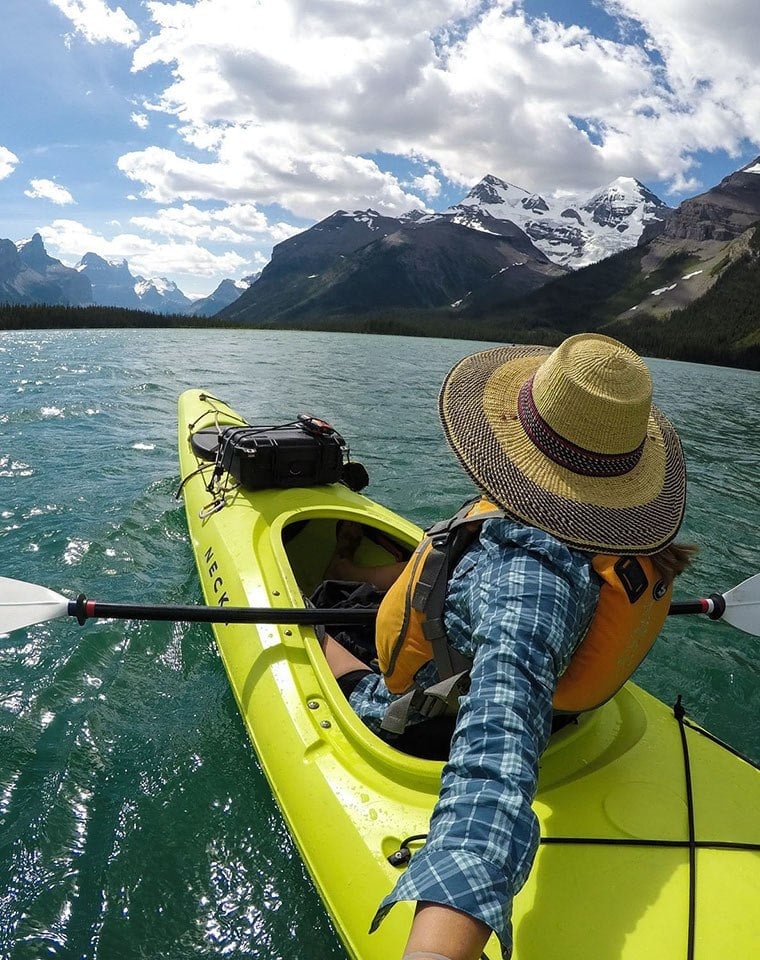
Kayak camping can feel a little intimidating at first, but it is easier than it seems. You’ll love the serenity it provides without feeling like you’re carrying the weight of the world on your back. With the right preparation, you’ll be enjoying the healing power of water in no time.
Do you have any kayak camping trips planned or any questions about this? Let us know in the comments below!

Jessica is a former local government nerd who fell in love with the outdoors when living in Montana at a young age. After years of working a government job in the midwest and only adventuring on the side, it was time for a change. They put their law-writing pen down to write about the outdoors and wellness instead and it has helped ensure many adventures to come.
Leave a Reply Cancel reply
Your email address will not be published. Required fields are marked *
Save my name, email, and website in this browser for the next time I comment.
Invalid email or password. Please try again.
You've shopped with us before!
Please set your password using the link below.
Create your Account
Already have an account?
Please correct the errors.
Passwords are case-sensitive, must be at least 8 characters in length, and must contain at least one special character.
- Include 8 or more characters.
- Include at least 1 special character.
For your free birthday gift!
Start your Expedition
Sign up with your email and start earning rewards with our exclusive loyalty program.
Explore More, Score More
Elevate your outdoor experience with Expedition Perks, where you earn points on purchases, get a bonus on your birthday, and more–it’s free to join!
Points On Purchases
Member Exclusives
Birthday Discount
Packing for a Multi-Day Kayaking Trip
Camping out of your kayak offers a feeling of freedom that few adventures on shore can match.
You paddle down rivers or float across open water during the day, and kick back by a campfire at night. Experienced multi-day paddlers can easily pack their boats for many days on the water, but your first time packing for more than a day’s paddle can be pretty stressful. Here are some pointers for planning your trip, a sample packing list, advice on organizing and keeping track of your gear, and tips on packing a whitewater or touring kayak for your first multi-day paddling trip on the river, lake, or ocean.
Gathering Your Gear & Supplies
Think like a backpacker. The gear required for a multi-day backpacking trip is very similar to the gear required for a multi-day kayaking trip. And just like a backpacking trip, weather, season, distance, trip duration, and group size all affect the type of gear and supplies you’ll need. The farther you go, the more supplies you need; the nastier the weather, the heavier and more serious your gear will become; and the larger your group, the more you can split up group gear to lighten the load of each boat. A detailed plan is necessary when preparing for any multi-day trip, and it will help guide your gear choices so you know what you have to pack.
Keep in mind that the type of water you’ll be traveling on will also affect the type of gear you need to carry. A river trip will require additional protective equipment for whitewater and perhaps a group toilet solution (such as a groover) if you’re traveling through government-controlled land, while a trip on open water will require additional navigational equipment, signaling and safety gear, and more. The type of water you travel on will also dictate the type of boat you use, and thus the storage space available for gear.
The Type of Boat Makes the Difference
Touring and sea kayaks are designed for comfort, efficiency, and most importantly, gear storage. A multi-day trip on open water requires gear and supplies, and these boats are designed with the storage space to hold it. Often, watertight bulkheads seal these storage spaces off from the rest of the boat and waterproof hatches offer quick access. Additionally, a touring kayak may have the added advantage of a day hatch where you can store small essentials that won’t fit or don’t belong in your PFD.
Whitewater kayaks are designed for performance first and gear storage second. Unless you’re paddling a creeker or a crossover-style hull, space is limited. Any storage space fore or aft of the cockpit may or may not be accessible by a hatch cover, and this storage space is rarely sealed off from the rest of the boat. This style of open storage space drastically simplifies packing, but it also leaves your gear more exposed. A little ingenuity and creativity will guide your hand when you’re packing a whitewater boat.
Both touring and whitewater boats require the same basic set of gear for a multi-day trip.
How to Organize & Pack Your Gear
You have the right gear. Now it’s time to pack your boat. While organization techniques are largely personal, even a basic plan can go a long way towards keeping track of your gear—nothing wastes more time and energy than completely loading and unloading a boat just to find that one rope or the spare batteries you desperately need. One simple organization strategy is to pack your gear into dry bags based on similar use. Pack one bag for clothing, one for sleeping gear, one for safety or first-aid, etc. Then you can label your dry bags clearly with waterproof tape and marker, or use dry bags of a variety of colors. Create a checklist of what’s in each bag, including your personal gear and any group gear that’s split among different boats in the group. Run through the checklist the morning before you leave, and then stash it somewhere that’s easy to find. You’ll have a quick reference for each bag and who’s carrying what when your group is large.
Add a high-capacity spare duffel bag for any trip with a portage. This bag can help you quickly round up and transport items in your boat that aren’t packed in a dry bag. Also, a spare bag can be used to move camping gear from your boat to your camp spot if you decide to camp away from the beach.
Dry bags come in a variety of shapes, sizes, weights, and colors. Use dry bags that are small enough to fit through the openings of your fore and aft hatches. It’s much easier to load and balance the weight of a boat with many small bags than it is with a few large bags. A brightly colored dry bag is particularly useful for your first aid kit, repair kit, or rescue kit. The bright color makes it easily recognizable among a pile of gear and quick for anyone in your group to find.
Always assume that your gear will get wet. The most waterproof hatch covers leak, dry bags eventually wear out, and boats roll and fill with water—it happens. Keep vital camp gear like your sleeping bag and insulating layers in your most secure dry bag. Garbage bags can be used to line or double-line the inside of dry bags for added protection. Squeeze as much air as possible out of each dry bag. Inches count when space is limited, so do everything you can to maximize fore and aft hatch space. Store everything else in older dry bags, compression sacks, or nylon duffels to keep loose items together.
Load Your Boat
There’s just as much art as science involved in loading a boat. Weight distribution and ease of access are your two primary concerns. Every boat has a maximum weight capacity, and you shouldn’t exceed it. Again, think like a backpacker. Simplify your gear selection and leave behind anything that isn’t vital. You should keep a few simple luxuries so you can still enjoy your trip, but choose wisely. Sharing gear among members of your group can drastically reduce the amount of weight in each boat. Instead of carrying two full kitchen kits, stoves, or bear bags, carry one of each and assign each to one boat.
A boat should be loaded with the weight low and centered. Lighter items should be packed far into the bow and stern and heavier items close to the cockpit. A properly balanced boat will have even fore-aft trim and will feel more stable in the water than an unloaded boat—maybe surprising, but true. Pack bags you need to access frequently closer to the hatches. Anything absolutely vital, like spare water or a small first aid kit, should be within reach of the cockpit. Water is heavy and prone to sloshing around, which can upset the balance of your boat quickly. Keep water low and close to the center of the boat. At most, you should carry a half gallon to a gallon of water—remember, you can always pump or purify more.
Fuel bottles are small and easy to jam into tight spaces, but beware: potentially hazardous liquids should be separate from your food. Stash fuel bottles at the very end of the bow or stern. You won’t need the fuel until you’re unloading your boat anyway, so isolate it in case of potential leaks. Electronics and large, metallic items should be far from navigational instruments or your compass. A few degrees of compass interference can cost you serious time and energy when you’re on the water.
The kind of food you bring is very much a personal choice. Some people can live off dried goods and protein bars, while others prefer fresh fruits and veggies. One tip for keeping perishables cold is to pack your fruits or veggies below the water line and close to the hull where cold water can help produce stay cool. Although you run the risk of bruising your apples or avocados, this below-the-water-line method is an easier way to keep food fresh longer, without the use of ice. Packaged food, fruits with tough skins, and the like can be packed loosely in your bags while foods affected by sogginess should be stashed inside a small dry bag.
Keep small essentials like a first aid kit, GPS, or backup knife in a day hatch if you have one. Every boater should have a knife and whistle attached to his or her PFD anyway, but a day hatch can offer additional quick-grab storage. Anything small and absolutely vital that won’t fit in your day hatch or your vest can be stored around, beneath, or behind your seat, but keep big dry bags and gear well behind the foot rests and free of your body and legs. In an emergency, you need to be able to roll your boat or wet exit without gear in your way.
Once you’re seated and your spray skirt is sealed around the cockpit, reaching past it isn’t an option unless you stop and undo the skirt. A deck bag can be attached to the deck of your sea or touring kayak to give you quick-reach storage if you don’t have a day hatch built into your boat. Whitewater boaters have to be craftier and plan carefully what’s stored in the pockets of their PFDs and near their seats. A deck bag isn’t an option, but safety essentials like a throw bag or bailing equipment should be within reach all the same. Many experienced whitewater kayakers will store small, vital gear in and around their seat by sliding their seat forward a few inches, releasing the back rest, stashing the gear inside, and then buttoning everything back up.
Keep the deck of your boat free and clear of heavy gear. A heavy or overloaded deck can make your boat dangerously top heavy, nearly impossible to roll, and prone to high wind on the open water. The deck of a touring kayak can hold a spare paddle under the stern bungees, a bilge pump just ahead of the cockpit under the bow bungees, and a small compass mounted to the front of the cockpit. Besides a groover or a throwbag (depending on personal preference), the deck of a whitewater boat should be completely clear. In heavy, churning whitewater, anything attached to the outside of a boat can quickly detach itself without warning.
Quick Recap
- Always assume your gear will get wet
- Use many small dry bags instead of a few large dry bags
- Pack heavy bags and gear low and close to the cockpit
- Pack light bags and gear at the ends of bow and stern
- Keep weight distribution even from bow to stern and side to side
- A properly balanced boat will feel stable and paddle easily
- Keep the deck free and clear of heavy, bulky gear
- Never forget the coffee
It might seem overwhelming at first, but packing a kayak is like packing for a car-camping trip—you just have to be a little more creative with space. Take a dry run with your fully packed boat and make any weight adjustments before you set off with your group. It never hurts to practice at home, too. After all your planning and organization, the hard work will pay off when you’re sitting at a campsite on a shore far away from the hustle and noise.
Essential Gear for River Trips
How to choose a kayak, whitewater kayak essentials: build your kit, downloadable checklist.

April 2, 2024
Planning a kayaking trip this summer? You’re in the right place! This is the only kayaking packing list you’ll need!
Why this blog? Hi there! My name is Maddy and I’ve been working as a sea kayaking guide and writer since 2018! I am committed to providing you good and accurate information to help you plan a successful wilderness trip!
Note: this blog uses affiliate links. That means if you choose to make a purchase, I make a small kickback at no additional cost to you.

What to Pack for Kayaking Trips:
Here are the basics of what to pack for a sea kayaking trip, from day trips, to full blown overnight kayaking trips!
What to Pack for Kayaking: Casual Day Trip
Here is everything you will need for a casual kayaking day trip:
- A kayak ! If you’re looking to kayak on protected lakes and rivers for mostly day trips, but want the option to overnight, the best kayak for you is a Wilderness Systems Pungo
- A PFD (lifejacket). If you’re going kayaking, wearing a PFD is a must. I love my Astral PFD , but NRS makes a good budget option .
- A paddle ! For casual kayaking, the paddle you have with you is the best option. For the best kayak paddle for beginners, check out the Werner Skagit or Aquabound StingRay
- Quickdry clothing and sun protection: For a good budget option for kayaking clothes, check out the REI Trailmade collection.
- Map and compass to navigate
- Three ways to call for help in an emergency (a whistle, a signaling mirror, a device to communicate with no cell service)
- A kayaking Safety kit
- A wetsuit . Is the water and air temperature combined less than 120 degrees F? You absolutely need to wear a wetsuit or drysuit . Hypothermia can happen year round and is one of the primary killers of casual paddlers.
- A first aid kit (more notes on first aid kits below!)
Note!! Every now and then you’ll see someone on the internet suggesting that wearing a winter coat and boots kayaking is a good idea. It is not. They will fill with water, become cold, and make self rescue nearly impossible. For a guide to winter kayaking, click here.

What to pack for a sea kayaking day trip:
For a sea kayaking day trip, you’ll need everything listed above and a little bit more. You’ll definitely want a spare paddle, wetsuit, a sea kayak , a spray skirt, and a marine radio. For sea kayaking, you’re also much more likely to need that wetsuit or drysuit.
Kayaking VS. Sea Kayaking: What’s the difference?
Planning on sea kayaking instead of casual kayaking? Sea kayaking, or coastal kayaking, refers both to a type of vessel and a different sport than recreational kayaking (often referred to just as kayaking).
A sea kayak is a kayak greater than 15ft in length with sealed bulkheads, or pockets of air, on either end. In general, in a sea kayak a spray skirt is used to keep waves out of the cockpit. This way, the paddler can kayak in large waves without swamping the kayak. If the boat capsizes, it will not fill with water and sink, unlike a recreational kayak.
A sea kayak and sea kayaking skills and experience are recommended on all exposed coast kayaking trips, anywhere with tidal currents, or anywhere with open water in excess of a few miles. It’s important to remember that sea kayaking is a different sport than kayaking, despite similar roots. Having kayaking experience does not mean you are ready to tackle a sea kayaking route.
Personally, I like to explain it as kayaking is to sea kayaking is what day hiking is to mountaineering— this sounds like an exaggeration, but it’s really not. Sea kayaking (especially on exposed coasts!) requires knowledge of complex weather patterns and tides, deep water rescues in big waves, navigating between islands and complex coast, gathering weather and sea state information and making informed choices about risk, tidal rapids, long term planning, and more.

What to Pack for an Overnight Kayaking Trip:
Wondering what to pack for an overnight sea kayaking trip? This is everything you need to pack for your overnight kayaking trip. You’ll need your camping gear + all the day trip kayaking gear listed above!
Sleep System for Sea Kayaking Trips:
Keep in mind that the key to a happy sea kayak camping trip is gear that will dry quickly. Despite your best efforts, things will be wet. This means choose synthetic over down!
- Nemo Temp Synthetic Sleeping Bag (budget friendly) OR Nemo Forte Endless Promise (higher end)
- Nemo Tensor Sleeping Pad (changed over from Big Agnes bc this one is equally comfortable comparably priced and packs down much smaller
- Waterproof Sea to Summit Compression sack for Sleeping Bag
- A freestanding lightweight tent. Read about the best tent options here!

Where can I get accurate weather for Sea Kayaking?
When sea kayaking, having accurate weather is extremely important. I recommend using at the barest minimum a VHF marine radio to get the Marine Zone forecast every morning before paddling. In addition, a Garmin InReach can also provide you with up to date weather.
When paddling, it’s really important to note that local weather patterns have far more influence on what you will experience on the water than the generalized forecast. Most especially in remote regions, the generalized forecast will not account for these local weather patterns. This is one of the reasons that hiring a local guide with extensive sea kayaking experience is a good idea, especially if you’re dealing with water temperatures below 70 degrees F.
In general, you can find a good weather forecast for your region at weather.gov in the US.
For example, if you’re paddling in a region with fjords you may be subject to katabatibc winds in excess of 45 knots— extremely dangerous to paddle in. Katabatibc winds are not likely to appear in a marine zone forecast, but a paddler with experience will know what conditions lead to these winds, and where they are likely to crop up.

Kitchen Gear 1-2 People, Sea Kayaking Trip:
- MSR camp stove
- Sea to Summit Collapsable Dish-wear
- 1-2 water bottles, Nalgene recommended. Metal water bottles will sink if dropped, even if you leave a pocket of air
- Sawyer Squeeze water filter (alt: iodine tablets)
- Spork (long enough to reach bottom of dehydrated meals while keeping your hand clean ideally)
- Tin mug if coffee drinker
- If with a group and making meals from scratch, Nalgene bowl to eat from. If not, straight from the bag
- Urssack for critter proofing. At the Havasupai campground I did hear reports of folks getting food stolen by raccoons in the night.
- Depending on where you’re paddling (freshwater or not) a water dromedary . If it’s hot out, I budget 5L per person, per day. Usually this is more than plenty.
What if I have a bigger group?
Going with a guided tour for your sea kayak camping trip? Odds are, unless otherwise stated, that your guide will be doing the cooking and kitchen tasks! (Camp cooking is one of my favorite parts of working as a kayak guide!)
If you are planning on doing all the cooking for your group, look into a weatherproof stove like the MSR whisperlite, industry standard for a lot of expedition style trips. You’ll also want to adjust your pot size to a larger pot, and depending on group size and meal needs, perhaps bring more than one pot or stove. I’ll assume that if you’re cooking for a large group, you already have experience meal planning and camp cooking for a group.
If not, I recommend starting with a guided tour, or having your party be responsible for their own meals in groups of 1-2. In my experience, otherwise things get messy when it comes to portion size, timing of meals, and camp tasks. Unless you have guide experience or sea kayak experience specifically with meal planning for groups, put the onus of meal planning on individual members of your part to plan for themselves.
(And like, not to be that person but review each others meal plans!! If the 20 year old who is an awesome paddler but doesn’t have expedition experience plans on bringing just ramen and m&ms for five days, make him repack and replan!!)

Packing Food for Overnight Sea Kayaking Trips:
Getting enough food as you’re paddling is really important. DO NOT just pack ramen and oatmeal to eat for days straight. You will be uncomfortable, and it can even be dangerous.
In general, budget one breakfast, one lunch, one snack, one dinner, and one dessert for a day. Personally, depending on the trip, I will either purchase pe-packed meals in advance, or dehydrate my own meals in advance.
If you will be kayaking longer than a few days or long distances (greater than 15 miles a day), I recommend coming up with a nutrition plan. I am not a nutritionist, but here are a few resources that are a good place to start:
- Ultralight Backpacking Meal Plan
- Backpacker’s Nutrition Guide
The excellent thing about kayaking is that you can fit more food than backpacking, and you can store food at the waterline of your kayak to “refrigerate” it while paddling. On shorter trips, I’ll eat better paddling than I do at home!
Pack more food than you think, and pick meals you know you will like . Those dehydrated meals at REI are not a fun thing to mess around with on a wilderness trip. Anything you don’t like and can’t finish you’ll have to pack out, and it will be much heavier now that it’s rehydrated. If you like pasta, just get pasta.

Electronics to pack for an overnight Sea Kayaking Trip :
- One external battery pack for phone (I usually bring a pretty beefy battery like this one!)
- Garmin InReach
- Canon Rebel SL3 (the most accident-proof budget-friendly camera out there; I have licensed photos to big magazines and tourism boards from this camera) + SD card + spare battery
- A good dry bag (see below!!)
What dry bags are the best for kayaking trips?
The best dry bags for kayaking are small, 10-20L thick and tough dry bags. You want a smaller bag to make packing your boat easier, and you want a tougher dry bag to prevent it from tearing.
After six years working as a sea kayak guide and expedition paddlers I have a lot of advice on what dry bags work for kayaking, and which do not. STAY FAR AWAY FROM LIGHTWEIGHT DRYBAGS. They will rip. You’re going to be jamming them into kayak hatches, and they will rip, they just will.
In addition, stay away from dry bags larger than 20L. While those bags are super great for canoeing or rafting, packing a sea kayak requires all your gear fit inside hatches; a large dry bag will make your life much more difficult and may even be impossible to pack.
For packing your clothes and sleeping bag for kayak camping, Sea to Summits dry bag compression sacks are the best you can invest in. These have lasted me almost four years now, and will keep your stuff both dry and compact. I wouldn’t submerge them, per se, but they are perfectly fine to keep water out for kayaking purposes.
Check out the tough Sea to Summit Big River dry bag in 13L , or the Sealine discover dry bags .
Looking for more on sea kayaking and overnight paddling? Check out this detailed guide to kayak camping for beginners !

Clothes to pack for a kayaking trip:
- Synthetic Puffy Jacket : highly packable, you want something that will pack down to nothing but add a lot of warmth at night.
- 3 pairs of Darn Tough Socks (1 pair worn, one for sleeping, one spare.)
- 4 pairs of underwear
- 1 pair of quick dry shorts
- One pair of long underwear (or just leggings that already have holes in them)
- Hiking pants Good for sun protection and keeping legs safe from rocks while hiking or paddling.
- 1 long sleeve wool baselayers top to wear, one to pack. I like Smartwool , it’s consistently had the most longevity of any baselayer I own. I recommend one baselayer to paddle in and one to sleep in minimum.
- One fleece pullover, thin weight
- Camp Sandals for camp (alt: crocs). I recommend a good pair of hiking sandals; if you get blisters on the way in you can hike in these instead to give your feet a break.
- Paddling Shoes: Neoprene booties OR an old pair of trail runners. In most seasons, I’m team trail runner in the water. This protects your feet from rocks and is WAY more comfortable to paddle in than sandals, which are likely to fill with rocks when you’re walking in water or on beaches.
- Thin wool gloves . Almost never regret packing these! We hiked in late March and it snowed on the way out.
- Raincoat & Rain pants )
- Compression Sack / Drybag for clothes
MISC things to pack for overnight kayaking:
- First Aid Kit
- Emergency Bivvy (Keep in a pocket accessible without removing your backpack. If you fall and break something and cannot easily move, this will make it easier to last a night. I have only ever used my emergency bivvys when helping strangers, but it has never not been worth bringing on the off chance I can help someone in trouble.
- Maps / Charts
- Signalling Mirror
- UL repair kit (tent split covered in duct tape and noso patch or two)
- Pillow (meh, often I do not bring)
- Hand sani, toothbrush, sunglasses
- Binoculars ( So much fun if on the ocean!)
- Bug shirt (if it’s buggy enough for the spray, it is for the shirt too)

First Aid Kit Notes:
You can purchase a first aid kit from REI prepackaged, but I like to build out my own for my own specific backpacking needs. I blister easily, and for me preventative blister care is super important.
This looks like cutting my toenails before trips, duct taping or KT taping over the parts of my feet that blister before I start hiking, and the second I start to feel a hotspot, I take off my hiking boot and use Glacial Gel patches and KT Tape to cover the spot before it becomes a blister.
It is far better to stop hiking and tend to your blisters early than to try and patch up an open wound. For me, I know that on long downhill sections I blister on my pinky toe and the outer edge of my foot, so I slap some duct tape on the usual spots before hiking so it doesn’t rub. On uphills, I blister at my heels, so I do the same.
The most common backpacking injuries tend to be blisters, dehydration, and burns from camp stoves. I come prepared for this by having a burn kit, rehydration packs, and practicing preventative First Aid by staying hydrated, preventing blisters, and being conscious of boiling water and camp stoves (ie, don’t let someone pour freshly boiled water into your coffee cup while you’re holding it!!)

How to pack a kayak for overnight paddling trips:
Wondering how to pack your sea kayak for an overnight paddling trip? Here are some quick tips:
- keep everything you’re going to need during the day accessible either on your deck, in your cockpit, or in your day hatch (the small hatch behind the cockpit in a solo boat.
- pack smaller drybags rather than larger for easier packing
- do your best to keep the weight on the kayak centered; this matters a lot more in solo boats than tandems.
- if you’re paddling into a headwind, load your boat bow heavy. In a tailwind, load your boat stern heavy. This often doesn’t make a huge difference but may be helpful for paddlers in solo boats on longer trips. Tandem boats have so much buoyancy that how you pack them weight wise doesn’t make much of a difference.
- bring some mesh bags or IKEA bags to help carry gear from your kayaks to camp
- ALWAYS ALWAYS ALWAYS carry your kayaks above the high water line and tie them off. Every kayaker will be burned at one point. Learn from my mistakes.
looking to dive into the outdoors this summer? Here’s where to start:
- check out the ultimate guide to planning a solo female road trip!
- learn about backpacking and packing for beginners!
- read about the best kayaking destinations near Seattle!
free resources like this one are made possible by paying subscribers of the Hello Stranger Newsletter . Join the newsletter today to connect with thousands of like-minded adventurers and get gritty and honest adventure stories delivered right to your inbox (aka read my diary).
Love reading about what to pack for a kayak trip share this article on social media:.


How to pack a cooler for camping (or any outdoor trip away from home)
W hether you’re camping for two nights or a full week, camping requires some careful forethought and planning. No one wants questionable food due to the cooler getting too warm too soon or an unidentifiable snack that’s soggy from falling out of an open package and into melting ice. With some consideration and preparation, you can easily pack a cooler for camping that will seamlessly serve you well throughout the length of your trip.
Type of cooler
The three greatest factors to consider when choosing the best cooler for camping are its ability to insulate well, its size, and its features. Brands like Yeti and ORCA are both top performers for backpack coolers because they are incredibly durable and excellent at insulating. If you are in the market to buy a fancy new cooler, you can get good sizes from both brands too, should you need a compact design or a more sprawling cooler depending on your needs.
A 56-quart cooler can hold enough food and keep it from spoiling for up to six and a half days, which makes it a versatile option for campers who go on both long and shorter trips.
If you know you’ll be moving the cooler around with other camping gear, opt for a cooler with wheels . And if you plan to have a cooler just for drinks and ice, find a cooler with long ice retention and easy drainage.
Cooling materials
The key to making these coolers keep your food cold and fresh for as long as you need it comes down to how well you pack it with cooling materials. That begins with getting the cooler itself as cold as possible before you even place the first item or ice pack inside. If you have a spare fridge in your garage and can somehow move shelves around to fit your cooler inside, let it chill for about a day prior to packing. Otherwise, place the cooler in the coldest spot you can, even if it’s outside, to let cool it.
Next, line the bottom with ice packs. If you need more than what you have but don’t want to buy additional ice packs, consider filling sealable plastic bags or food storage containers with water and freezing them. Do, however, stay away from using ice cubes that don’t last as long and actually cause the other ice cubes to melt faster once they start floating those that have melted first.
After that first layer of ice packs is down, place a thin, insulating layer of cardboard, a broken down and cleaned milk carton, or even a foam pad between the ice packs and your food. This benefits the cooler in two ways. It will keep your food organized by preventing it from falling between the ice packs, and if there is water in the bottom of the cooler, it will also keep the food from turning into mush. It’s also a good idea to place an additional insulating layer like this between the food and the lid of the cooler, too.
Pack food and drinks the right way
Consider which foods need to stay the coldest as well as what you will need later in the trip. Those items should go at the bottom. Add another layer of ice packs and continue this layering pattern of food and ice packs until you reach the top.
Reserve one side of the cooler for drinks so you can easily reach in and find them without leaving the cooler open for too long. Always latch it all the way so none of the cold air slips out. The rest of the food should be well organized so you know where everything is and can easily find it without having to stand over the cooler, pulling tons of items out. One way to prevent this from happening is to pack by meal. The last day should be on the bottom while the first day should be at the top of the cooler. You can even incorporate a separate section for snacks.
Something to consider as well is a second cooler for drinks. You’re likely going to be reaching in for drinks like water, soda, or beer a lot more often than you are ingredients for meals. So, if you can, packing a separate drinks cooler will allow you to keep the food a lot colder in the long run.
Coolers are at the top of the list for camping cooking gear and a great way to make everything last as long as possible is to freeze the items that need to stay cold prior to packing them. Things like meat, water bottles, and even fruit can be frozen and then packed.
It’s also helpful to remove the original packaging for most food and repack it in sturdier containers that are less likely to leak. This also allows you to prevent any wasted space because you can do meal prep and package it well. One example is eggs. You can crack them into a plastic bag, add any toppings or mix-ins you might want, such as veggies , then seal it and pack it in a much smaller space.
How to pack sandwiches
Packing sandwiches in particular can be tricky, so here are some tips on packing them in a cooler. First, use leak-proof containers or wrap sandwiches tightly in plastic wrap or reusable food wraps to prevent moisture transfer and keep them from getting crushed by other items. Pack enough ice packs or blue ice around the sandwiches to maintain a cold temperature, and place sandwiches upright in the cooler, like books on a shelf, to avoid them getting squished.
Put sandwiches toward the top of the cooler, where the temperature stays coldest, and consume them before other items. Some additional tips include packing the spreads separately and adding them to the sandwiches when you eat them. You could also toast the bread before your trip to add a slight barrier against moisture.
As you use your camping meals and containers become empty, you can drain off any water from the bottom of the cooler into the now-free containers. Though it won’t freeze, the water should still be cold enough to help keep the rest of the cooler cold within the sealable containers without leaking.
The post How to pack a cooler for camping (or any outdoor trip away from home) appeared first on The Manual .
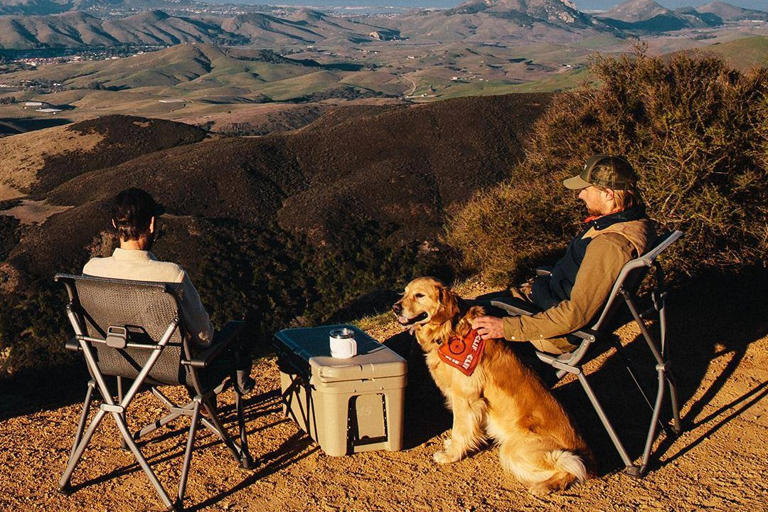

COMMENTS
Distributing / centering weight front to back and side to side. Photo by Luke Rovner (Kayak Hipster) Just like when packing a car for a trip, you want to try to distribute the weight of your packed items in your kayak for the best possible handling. Try to keep heavy items as close to the bulkheads/middle as possible, as well as the centerline ...
Waterproof Headlamp $50. Most of the time, you kayak while the sun is out to play and head on land to set up your campsite before night rolls in. But just because the sun sets, doesn't mean the fun have to stop. Black Diamond's Storm Headlamp provides a bright beam to navigate the shoreline and the campsite.
HOW TO PACK YOUR KAYAK FOR A CAMPING TRIP - COMPLETE GUIDE + BONUS PACKING LIST. 8 BEST KAYAKS FOR YOUR FIRST KAYAK CAMPING TRIP - COMPLETE GUIDE. About; Latest Posts; Stacy Bressler. Stacy Bressler is an avid outdoorswoman, wife, and mother of three who lives in Jackson, Wyoming. She loves all things camping and enjoys sharing helpful tips ...
Camp kitchen equipment. Water treatment and bottles. Stove, fuel and cookset. Food and snacks. Mess kit. Rope to hang bear bag overnight. [ Read more: 9 Accessories For The Comfiest Kayak Camping Trip Ever ]
Step 1: portage all your drybags and gear. Step 2: portage your kayak. Carry it with the cockpit rim sitting on your shoulder. Because of their lack of cockpit to carry on your shoulder, sit-on-top kayaks can be tricky to portage. The best advice for how to portage a sit-on-top kayak is to do it with a buddy.
Think of canoes and kayaks as giant, 16-foot-long duffel bags with few dividers, compartments, or pockets. Packing one for a camping trip can be a mess if you don't have a plan, and a poorly ...
Master kayak packing for multi-day trips with these tips on staying flexible, understanding kayak volume, weight distribution, and more. By David Cannamore Updated on May 11, 2023 Overnight kayak camping provides similar exploration opportunities as a backpacking trip, but without the need to lug all the gear on your back.
Here are a few things to keep in mind. Keep Your Kayak Stable: To do this, pack your kayak so it'll have a low center of gravity. Pack the heaviest items low in the boat, towards the center, and evenly from side to side. Keep Your Kayak in Trim: This refers to your kayak's tilt front-to-back.
Strategic Packing Tips. To achieve a well-balanced kayak, consider the following packing tips: Heavier Items at the Center: Place the heavier items closer to the kayak's center of gravity, near your feet. This could include camping equipment, water containers, or any other dense gear.
Essential Gear for Kayak Camping. Packing for a kayak camping trip can be challenging, as space is limited and weight is a concern. Here are some essential items that every beginner should bring on their first trip: Kayaking Gear. Kayak: The most important piece of gear. You can either buy or rent a kayak, but make sure it's suitable for your ...
Packing for a kayak camping trip is an exercise in ruthless efficiency. You'll need to evaluate each piece of gear not just for utility but for multi-use functionality given tight storage constraints. Resist the urge to over-pack for unlikely scenarios. Extra "just in case" items often go unused while weighing you down with additional ...
Essential Kayak Camping Gear. For backpacking enthusiasts, packing for a kayak camping trip will feel familiar. You'll be bringing most of the same gear, switching out your backpack for a kayak. Since you won't have to carry all of your gear, you'll have a little more room for a luxury item or two. Here are some must-bring items:
Preparing for a kayak camping trip is a little like backpacking, but requires some modification and additional preparation to be successful. Seth breaks down...
Packing for a kayaking trip differs from packing for other outdoor adventures. Most kayak storage space is narrow compartments with some hard-to-reach areas. Experienced campers become very accomplished at this version of Tetris, and you'll be amazed at how much kayak camping gear you can squeeze into your boat.
Packing for a Multi-Day Kayaking Trip. Camping out of your kayak offers a feeling of freedom that few adventures on shore can match. You paddle down rivers or float across open water during the day, and kick back by a campfire at night. Experienced multi-day paddlers can easily pack their boats for many days on the water, but your first time ...
Kayak camping rocks! That being said, it's a little harder to pack for a kayak camping trip than a canoe camping trip (if you're using a sit inside kayak), ...
Here are the basics of what to pack for a sea kayaking trip, from day trips, to full blown overnight kayaking trips! What to Pack for Kayaking: Casual Day Trip ... Keep in mind that the key to a happy sea kayak camping trip is gear that will dry quickly. Despite your best efforts, things will be wet. This means choose synthetic over down!
This video in our Kayak 101 series goes over how to properly pack your kayak for a camping trip.The information provided in this video by MSP Holdings, L.L.C...
W hile canoe trips are about enjoying the great outdoors, exploring the wilderness and challenging yourself, packing the necessary gear makes it all possible.. Before you head to the put-in, run carefully through our canoe trip packing list to make sure you have the essentials covered. We have broken things down into kitchen, gear, and safety items and added some of our expert advice along the ...
In general, make sure you understand what the campsite has to offer before you start packing. Some campsites have restrooms, showers, running water, tables, activity areas, and grills, among other ...
Packing a cooler for camping comes down to keeping the food as cold as possible. Use ice packs, additional insulation, and freeze the food before packing. The post How to pack a cooler for camping ...
Step 1: Consider The Type of Travel. Before you even open your suitcase, you should think about the kind of trip you're going on and how much space essential items will take up.